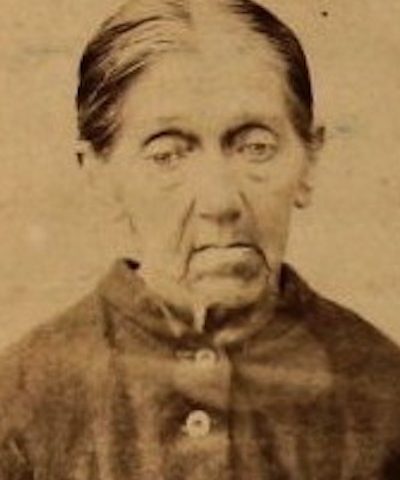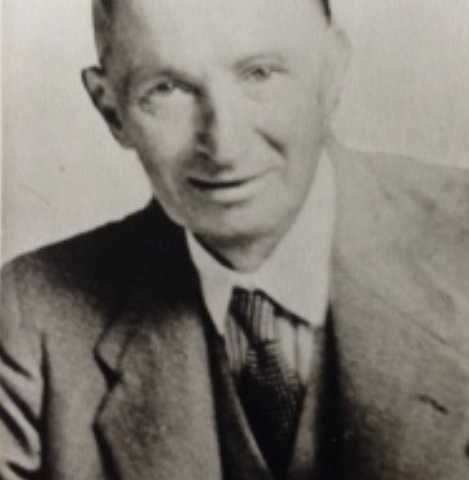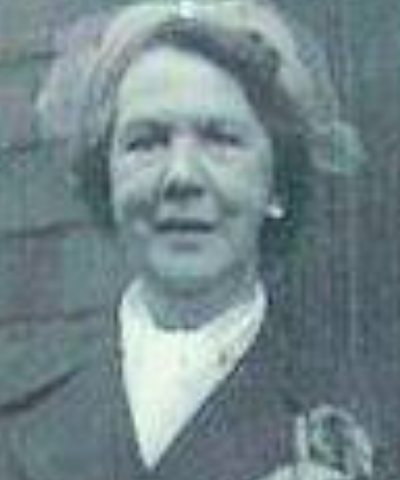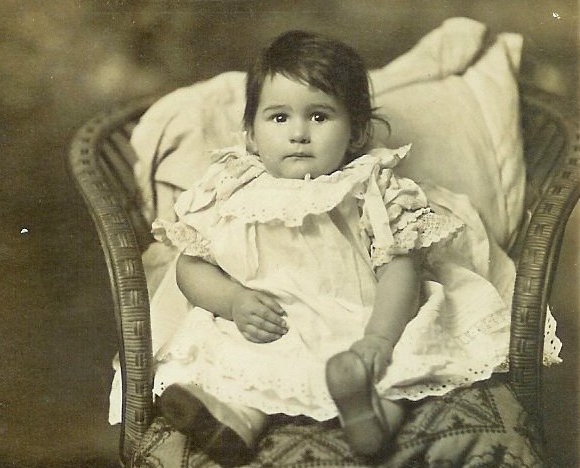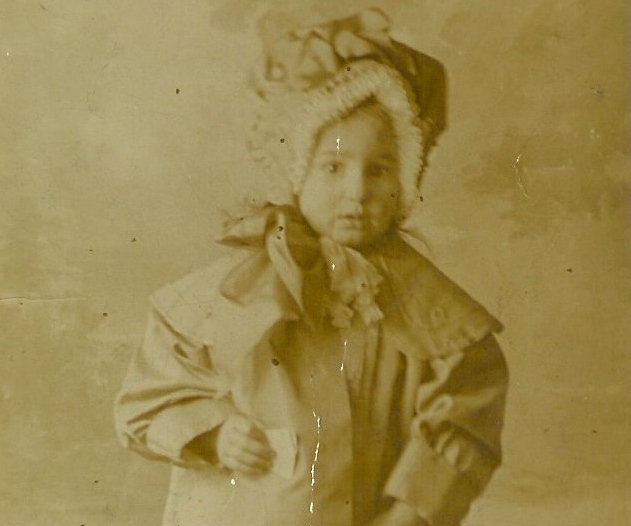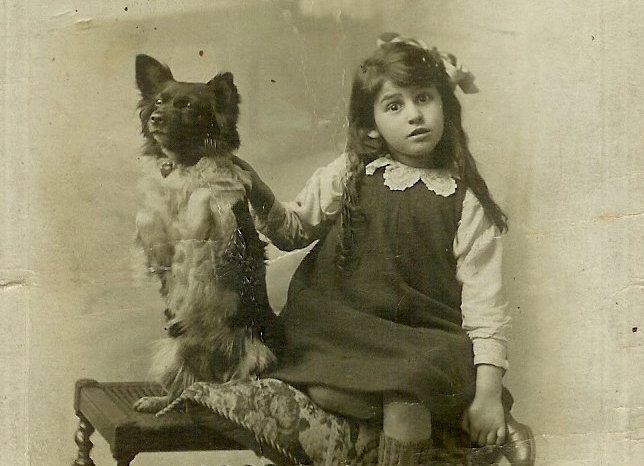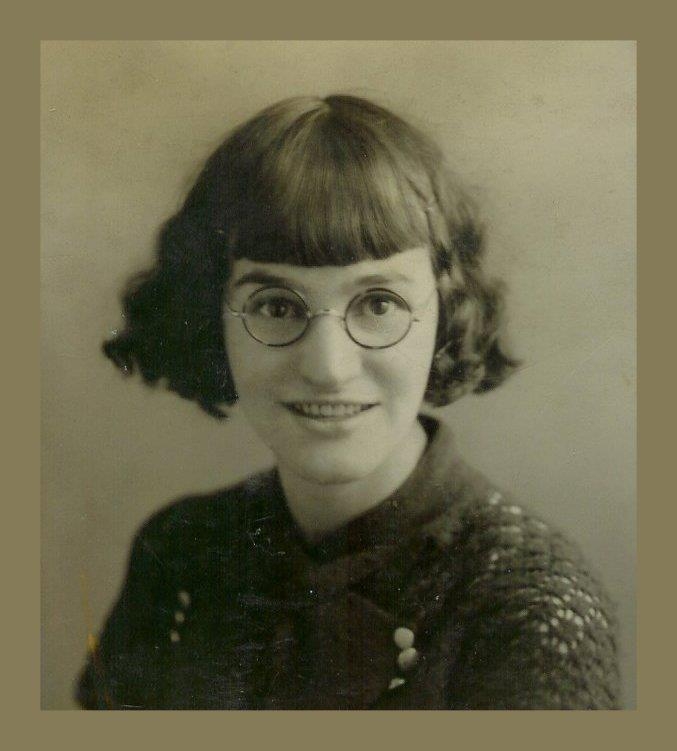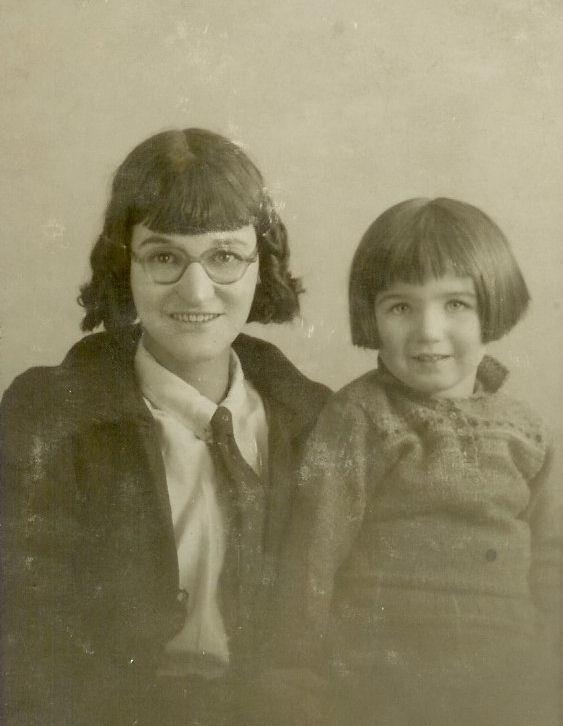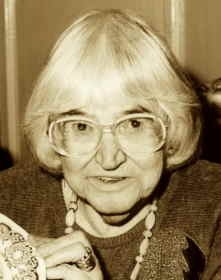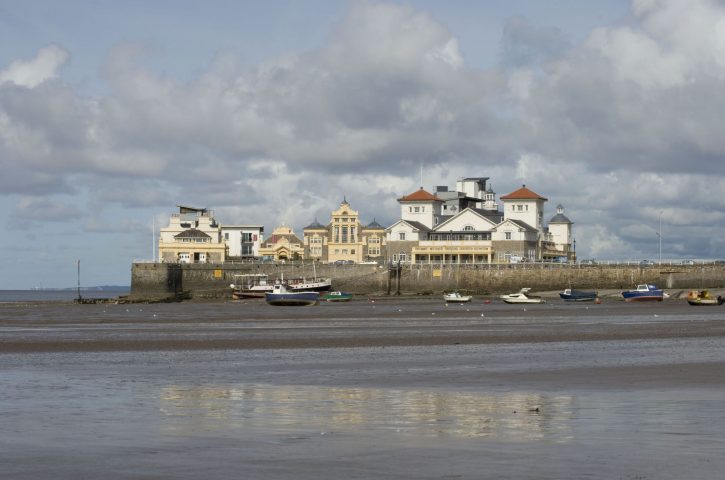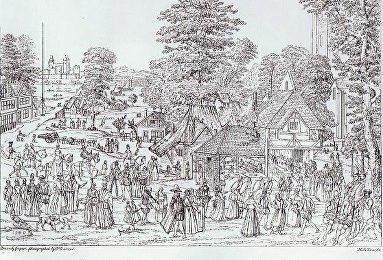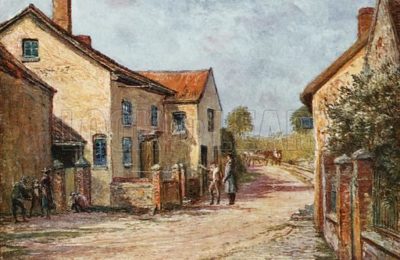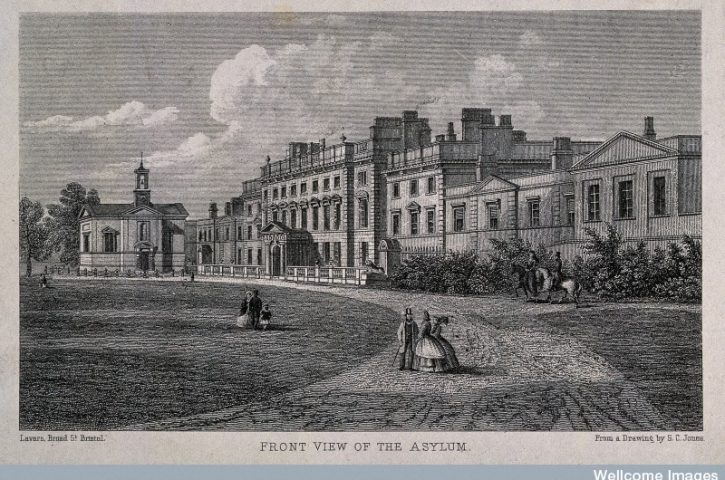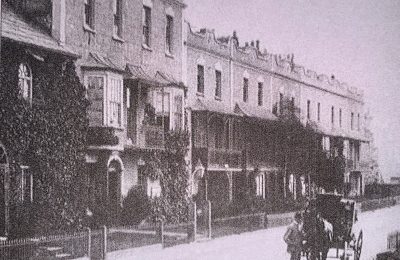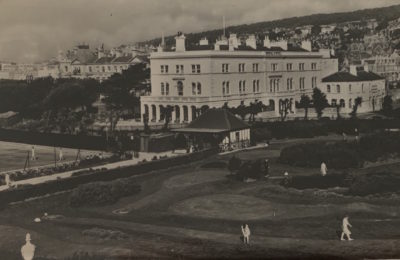The following timeline is very much a cluttered and continual work-in-progress. My eventual aim is to build up a complete timeline of events and significant moments connected to my own family history, on both sides of my paternal family history (surnames JAMES, FRY, LAKE) and my maternal side (BRINE & MAPLESDEN). I have begun by roughly timelining a hundred or so years of historical events to give some context, before introducing some of my ancestors, and continuing their timeline while punctuating it with historical points of interest. These include cultural, religious and other developments, which are relevant nationally, globally, and in the locations which were significant to my own family’s past.
My overall aim, in building this overall Timeline up in such a way, is to attempt to set my own past relations against a backdrop of what is known about the locations, the times, and the news worthy stories and events of their times. My hope is that one day, when sufficiently complete, it might help to illuminate the most likely thoughts, ideologies and everyday conversations which might have occupied them or which they may have taught and passed on to their own children through the literature they read and the stories they told. Ultimately, I hope it will help to put a little proverbial ‘flesh on the bones’ of my now deceased ancestors.
GENERAL HISTORICAL EVENTS TIMELINE (Last Updated 24th May 2020)
1642
Charles I’s reign (1625-1649) ushered in a long and bloody civil war between the King and Parliament in England. This lasted from 1642-1649. In London, Charles lost control of the Tower of London to the Parliamentarians and in 1649, Charles was executed. In 1653, Oliver Cromwell became Lord Protector.
1660
The monarchy is restored and Charles II, the ‘Merry Monarch’, takes the throne. He was thought to be a popular but weak King. He fathered numerous illegitimate children but had no legitimate heir.
1662
The Act of Uniformity (24 August 1662) prescribed that any minister who refused to conform to the Book of Common Prayer by St Bartholomew’s Day should be ejected from the Church of England. This date became known as ‘Black Bartholomew’s Day’ among Dissenters, a reference to the fact that it occurred on the same day as the St Bartholomew’s Day massacre of 1572. Oliver Heywood estimated the number of ministers ejected at 2,500.[2]
Although there had already been ministers outside the established church, the Great Ejection created an abiding concept of non-conformity. Strict religious tests of the Clarendon Code and other Penal Laws left a substantial section of English society excluded from public affairs, and also university degrees, for a century and a half (up to around the 1800s). Culturally, in England and Wales, nonconformism would endure for longer than that.
1665
The Great Plague.
1666
The Great Fire of London.
St Paul’s Cathedral was built by Christopher Wren.
1685
Charles II’s younger brother, James II takes the throne. He had converted to Catholicism in 1670, having previously raised his two daughters as Protestants. He was hated by the people because he persecuted the Protestant clergy. The Monmouth uprising occurred, where Monmouth, an illegitimate son of Charles II, who was himself a Protestant, tried to overtake the throne. Then the Bloody Assizes occurred, and Parliament asked William of Orange to take the throne. William was married to Mary, James II’s Protestant daughter.
1688
The Toleration Act was passed. The Act allowed freedom of worship to nonconformists who had pledged to the oaths of Allegiance and Supremacy and rejected transubstantiation, i.e., Protestants who dissented from the Church of England such as Baptists, Congregationalists or English Presbyterians, but not to Roman Catholics. Nonconformists were allowed their own places of worship and their own schoolteachers, so long as they accepted certain oaths of allegiance.
1696
The manor estate of Weston-super-Mare owned by the Winter family, was sold to John Pigott of Brockley. He became Lord of the Manor.
1702
Queen Anne takes the throne (1702-1714). She was the second daughter of James II. During her reign, the United Kingdom of Great Britain was created. She was a High Church Protestant. After Anne’s death, the line of succession went to Sophia, daughter of Elizabeth of Bohemia, James I’s only daughter, but then passed to her son George. He didn’t speak English and came to England aged 54. This meant that national policy was left to the government of England. Sir Robert Walpole became Britain’s first Prime Minister.
1703
WESTON-SUPER-MARE: Found in Ubley Parish Registers (right hand column) is a Vicar’s eye witness account of the Great Storm of 1703 in Weston. This storm must have devastated Weston. “November the twenty sixth day at even (?) it pleased God to afflict us with such a tempest and — which put the whole land in a great fear and much danger. In so much that we were afraid to lye in our beeds (sic) and afraid to sit by the ffire (sic), we were afraid to abide in our houses and afraid to go forth into the streets. It was such a wind that it did shake —- (something about shaking the roofs)—-. Such a wind that did in a moment threaten to blow the land into the sea and — the sea into the land and it is a night to be much affeared of all the people of England in this generation”.
1715
The Jacobites (followers of James Stuart, son of James II) attempted to supplant George but failed. George didn’t spend much time in England.
Chronic hunger and malnutrition were the norm for the majority of the population of the world including Britain and France, until the late 19th century. Until about 1750, in large part due to malnutrition, life expectancy in France was about 35 years and about 40 years in Britain.
1720
The South Sea Bubble Scandal.
1727
In 1727, George II, only son of George I, takes the throne and would be King until 1760. He was more English than his father, but he still relied on Sir Robert Walpole to run the country.
Family History in Context
1739
BIRTH: In London, in September 1739, Thomas William JAMES (who would grow up to be a Tailor) is born in the parish of Westminster. He is believed to have been born to a couple named William JAMES and Ann (Mary) JAMES (nee AUSTIN) who already had a daughter aged 2, named Mary JAMES. Thomas William JAMES was baptised on 16th September 1739 at Saint Clement Danes, Westminster, London.
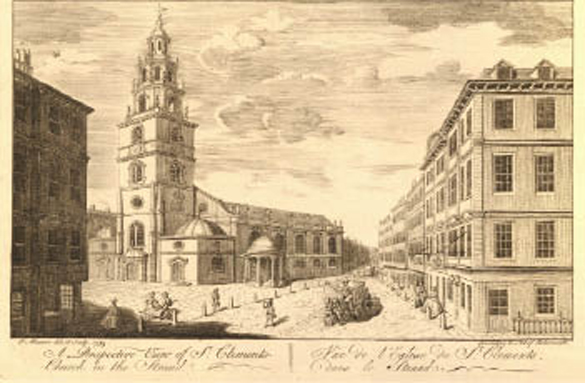
Meanwhile, in Bristol, in 1739, the well-known theologian and evangelical preacher, John Wesley, established the first Methodist Chapel in Broadmead.
1740
BIRTH: In July 1740, Keturah BUTT is born in Gillingham, Dorset (which is registered on the Canterbury district records). She is the second child of her parents John BUTT and his wife Rachael BUTT. The couple already had a son, Thomas BUTT (who had been born in March 1739). Keturah was baptised on 23rd July 1740. She would grow up and go on to marry Thomas William JAMES at Saint Clement Danes, Westminster.
1743
George II was the last English King to lead his army into battle, at Dettingen.
1745
In 1745, the Jacobites tried once again to restore a Stuart to the throne. Prince Charles Edward Stuart, “Bonnie Prince Charlie”, landed in Scotland. He was routed at Culloden Moor by the army under the Duke of Cumberland, known as ‘Butcher’ Cumberland. Bonnie Prince Charlie escaped to France.
1747
Bristol was now Britain’s busiest slave trading port and operated a very busy port with trans-atlantic trade.
1753
There was growing economic unrest in Bristol.
1759
Joseph Fry (probably no relation to my own family) begins chocolate manufacture in Bristol.
1760
George III takes the throne. He was the Grandson of George II and the first English born and English speaking Monarch to rule since Queen Anne. His reign would be considered to be one of elegance. It saw the likes of some of the greatest names in literature like Jane Austen, Byron, Shelley, Keats and Wordsworth. It was also the time of great statesmen like Pitt and Fox, and great military men like Wellington and Nelson. It would also see the start of the industrial revolution which would change the working lives and living conditions of people across Britain.
At the beginning of the Industrial Revolution, inland transport was by navigable rivers and roads, with coastal vessels employed to move heavy goods by sea. Wagonways were used for conveying coal to rivers for further shipment, but canals had not yet been widely constructed. Animals supplied all of the motive power on land, with sails providing the motive power on the sea. The first horse railways were introduced toward the end of the 18th century, with steam locomotives being introduced in the early decades of the 19th century. Improving sailing technologies boosted average sailing speed 50% between 1750 and 1830.[81]
The Industrial Revolution improved Britain’s transport infrastructure with a turnpike road network, a canal and waterway network, and a railway network. Raw materials and finished products could be moved more quickly and cheaply than before. Improved transportation also allowed new ideas to spread quickly.
Textiles were the dominant industry of the Industrial Revolution in terms of employment, value of output and capital invested. The textile industry was also the first to use modern production methods
1764
MARRIAGE: Thomas William JAMES, now aged 25 and working as a ‘Taylor’ in the parish of Westminster where he’d been born, marries Keturah BUTT, now aged 24, who was also living in the parish. They marry on Boxing Day (26th December 1764) at Saint Clement Danes Church, Westminster in London.
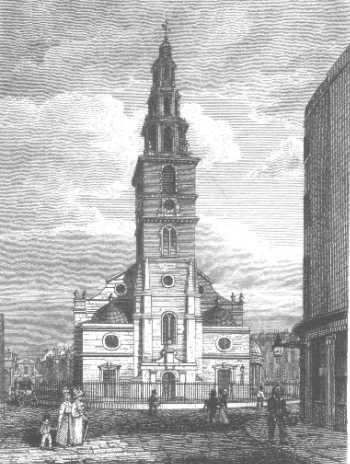
RELOCATION: At some point following the marriage, it seems that Thomas JAMES’ whole family (including his parents William and Ann JAMES and also his sister, Mary JAMES) moved together to a beautiful and picturesque village called Brislington, in Somerset, and they took Thomas’ new wife Keturah JAMES (nee BUTT) with them.
They may have been drawn there for work, since by this time, the landed gentry from Bristol, now the second busiest city next to London and a major port, were making the Brislington area popular with the upper classes. Or perhaps they were drawn to leave the city due to poor living conditions, poverty or poor sanitation, and they longed for a more sedate, country, village lifestyle.
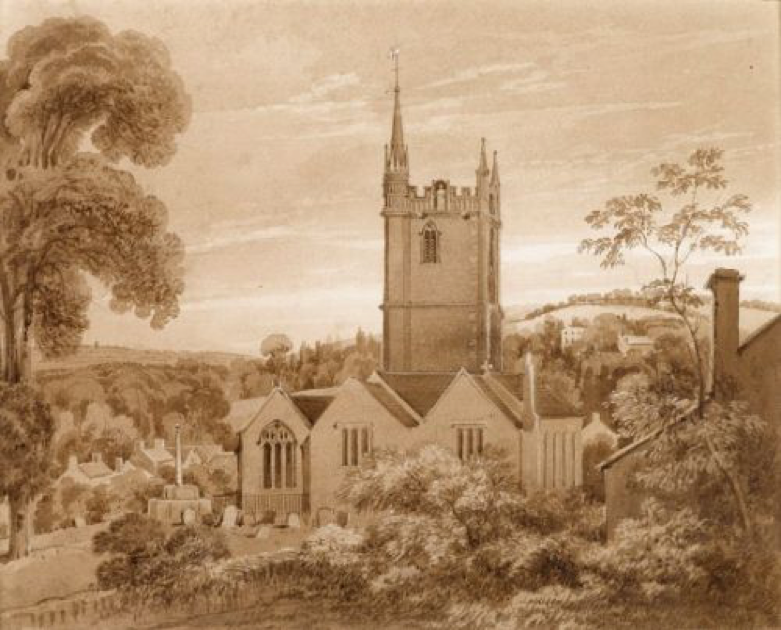
Alternatively, they may have been drawn there by talk of the rise in Non-Conformist religion in that area. Methodist John Wesley was living in Broadmead, Bristol at this time and preaching openly. He would preach in the open air to miners and brickworkers and the JAMES family were most likely interested in non-conformist views in their own religious beliefs, though they were likely still attending the Anglican church every Sunday.
1765
BIRTH: In Brislington, Thomas William JAMES and Keturah JAMES (nee BUTT), have their first child together, a son. They name him William JAMES, most likely after Thomas’ own father, William JAMES which would have been customary in those times.
1767
BIRTH: In January 1767, two baby girls are born in Bisley, Gloucestershire, both called Mary DAVIS, one to a Daniel DAVIS and one to a Richard DAVIS and they are both baptised in the same month. One of them may have grown up to marry into the James family in 1790.
1768
BIRTH: In Brislington, Thomas William JAMES and Keturah JAMES (nee BUTT) have their second son, (my direct ancestor and 4 X Great Grandfather) who they name Thomas JAMES , most likely after his own father. He would go on to spend his whole life there in Brislington, and he would become a successful Carpenter and also a non-conformist, Congregational, Church co-Founder and builder of the first meeting house there.

1770
BIRTH: When the young Thomas is only two years old, and his older brother is five, Thomas William JAMES and Keturah JAMES (nee BUTT) have their third child, their first daughter together. They name her Sarah Keturah JAMES. Could this be a clue to Keturah’s Mother’s name I wonder?
In Bristol, the Plymouth Porcelain company move to Bristol city and begin china manufacture there. Bristol would become known for its ‘Bristol China’. Perhaps the James family would have bought some Bristol china tea sets and service plates.
1773
Meanwhile, the ‘Boston Tea Party’ was the first sign of the troubles that were set to come in America. Events overseas and may have been the subject of talk among locals.
In 1773 the poet, philanthropist and social reformer Hannah More went to the village of Uphill near Weston-super-Mare to convalesce. Her friend, Reverend William Leeves, who was rector at Wrington, a village some 16 km to the north east, was so taken with the area that he built a cottage overlooking the sea at Weston in about 1791. The cottage still survives as The Old Thatched Cottage Restaurant, and is considered to be Weston’s oldest surviving building.
1774
DEATH: Thomas William JAMES’ mother, Ann (Mary) JAMES (nee AUSTIN) dies in Brislington at the age of 61. She leaves behind her son and his wife, and her three young grandchildren, William (now 9) and Thomas (now 6) and Sarah (4).
BIRTH: A record was found for another William JAMES born to Thomas and Keturah JAMES and baptised on 18th August 1774 in Bristol. It’s not clear here whether their first son William died and they had another son called William or whether this record is for a different couple.
BIRTH: A Mary Anne WEBB is born in Holcombe, Somerset (she may have been the Mary who Thomas JAMES would grow up to marry in around 1790 but this is not clear from the available records).
1775
In Hampshire, Elizabeth Maiden is born to her parents William Maiden and Elizabeth (nee Boyce). They were non-conformists and Elizabeth was baptised in a non-conforming church in Southampton, Hampshire.
1776
On 4th July 1776, The American Colonies proclaimed their independence having won against Britain. Inside Parliament, the primary concern changed from fears of an over-mighty monarch to the issues of representation, parliamentary reform, and government retrenchment. Reformers sought to destroy what they saw as widespread institutional corruption,[84][85] and the result was a crisis from 1776 to 1783. The peace in 1783 left France financially prostrate, while the British economy boomed thanks to the return of American business. The crisis ended after 1784 thanks to the King’s shrewdness in outwitting Charles James Fox (the leader of the Fox-North Coalition), and renewed confidence in the system engendered by the leadership of Prime Minister William Pitt. Some historians suggest that loss of the American colonies enabled Britain to deal with the French Revolution with more unity and better organization than would otherwise have been the case.[84][85] Britain turned towards Asia, the Pacific, and later Africa with subsequent exploration leading to the rise of the Second British Empire.
King George III was considered to be well-meaning but he suffered from mental illness due to intermittent porphyria and eventually would become blind and insane with his son ruling as Prince Regent in 1811 until George’s death.
DEATH: Thomas William JAMES’ father, William JAMES, dies in Brislington at the age of 68 leaving behind his three young grandchildren William (11), Thomas (8) and Sarah (6).
1778
A new edition of the influential Christian allergory text, The Pilgram’s Progress was published.
1779
WORKING LIFE: A record exists for a young Thomas JAMES to have apprenticed to a Master Mast Maker in Bristol, named James JAMES. If this is Thomas JAMES from this family, then he would have been only 11 years old at the time. Bristol was, at this time, a very busy port and the centre of the slave trade moving slaves from across the Atlantic.
The Nonconformist Relief Act 1779 (19 Geo. III c. 44) was Act of the British Parliament. The Act allowed any Dissenter to preach and teach on the condition that he declared he was a Christian and a Protestant; took the Oaths of Allegiance and supremacy; and took the Scriptures for his rule of faith and practice
1780
BIRTH: In Bisley, Gloucestershire, Richard FRY is born and baptised. His father was named William FRY.
NEWS: In Brislington, Brislington Common is closed. It will later be purchased by Edward Long Fox in order to build and establish the first purpose built, humane, lunatic asylum.
Slavery was being abolished in a number of North American states. Between 1780 and 1804 all Northern states, beginning with An Act for the Gradual Abolition of Slavery from Pennsylvania in 1780, passed legislation abolishing slavery, sometimes by gradual emancipation. Massachusetts ratified a constitution that declared all men equal; freedom suits challenging slavery based on this principle brought an end to slavery in the state. In Virginia, similar declarations of rights were interpreted by the courts as not applicable to Africans or African Americans. All the states banned the international slave trade by 1790. South Carolina did so in 1787 but in 1803 reversed itself.[2] During the ensuing decades, the abolitionist movement grew in Northern states, and Congress regulated the expansion of slavery as new states were admitted to the Union. The United States federal government criminalised the international slave trade in 1808 and made slavery unconstitutional in 1865 as a result of the American Civil War.
Abolitionism in the United States was an expression of moralism,[4] and frequently had a religious component to it: slavery was incompatible with Christianity, according to the many religious abolitionists. It often operated in tandem with another social reform effort, the temperance movement.
The Industrial Revolution was the transition to new manufacturing processes in Europe and the United States, in the period from about 1760 to sometime between 1820 and 1840. This transition included going from hand production methods to machines, new chemical manufacturing and iron production processes, the increasing use of steam power and water power, the development of machine tools and the rise of the mechanised factory system. The Industrial Revolution also led to an unprecedented rise in the rate of population growth.
Textiles were the dominant industry of the Industrial Revolution in terms of employment, value of output and capital invested. The textile industry was also the first to use modern production methods
1781
WORKING LIFE: Thomas William JAMES, still working as a Master ‘Taylor’ in Brislington, now takes on an apprentice, Thomas CHAPPELL.
Textiles – mechanised cotton spinning powered by steam or water increased the output of a worker by a factor of around 500. The power loom increased the output of a worker by a factor of over 40.[31] The cotton gin increased productivity of removing seed from cotton by a factor of 50.[22] Large gains in productivity also occurred in spinning and weaving of wool and linen, but they were not as great as in cotton.
In 1785 Hannah More, educator and social reformer from Bristol, moved to a cottage in rural Somerset, “to escape from the world gradually”.[1] She started a school at Wedmore which received strong opposition from the locals, who petitioned the Dean of Wells to remove her.[1]John Scandrett Harford of Blaise Castle was a prodigious benefactor to More’s schools in the 1790s, and More modelled the idealised hero and heroine in Coelebs in Search of Wife (1809) on Mr and Mrs Harford.
1786
WORKING LIFE: If the record for an apprenticeship for Thomas JAMES was correct, then in 1786, a young Thomas JAMES, aged just 18, would have completed his apprenticeship.
22nd February 1786: Hannah BEACHAM married William GOULD by licence at the parish church in Weston. She left her mark, so would have been illiterate. Their first child, Ann, who was always known as Nancy, was christened 8 months later. The young family settled in a cottage in The High Street.
1787
WORKING LIFE: A man named Thomas JAMES, listed as a Carpenter in Bristol, takes on a young William JAMES to be his apprentice (These JAMES’ may well be related). If this is our Thomas JAMES, then he would only have been around 19 years old himself.
Iron making – the substitution of coke for charcoal greatly lowered the fuel cost of pig iron and wrought iron production.[1]:89–93 Using coke also allowed larger blast furnaces,[32][33] resulting in economies of scale. The steam engine began being used to pump water and to power blast air in the mid 1750s, enabling a large increase in iron production by overcoming the limitation of water power.[34] The cast iron blowing cylinder was first used in 1760. It was later improved by making it double acting, which allowed higher blast furnace temperatures. The puddling process produced a structural grade iron at a lower cost than the finery forge.[35] The rolling mill was fifteen times faster than hammering wrought iron. Hot blast (1828) greatly increased fuel efficiency in iron production in the following decades.
Invention of machine tools – The first machine tools were invented. These included the screw cutting lathe, cylinder boring machine and the milling machine. Machine tools made the economical manufacture of precision metal parts possible, although it took several decades to develop effective techniques
____________________________________________________________________________________________________________
1788
In 1788, John Wesley, the theologian and Evangelist, gave a speech against slavery in Bristol. He was the founder of the non-conforming Methodist Church. Thomas James may have listened to the speech or heard about it at the age of around 20 years old.
Hannah More became one of the leading figures in the Abolition movement, and one of the few women involved in running the national campaign. She used her writing talents to support the movement, inspired by her new-found Evangelical Christian faith and friends such as the MP, William Wilberforce. She published Slavery, a Poem to launch Wilberforce’s Parliamentary campaign for the abolition of the slave trade in 1788. Her poems, such as Slavery and The Sorrows of Yamba, popularised the political debate.
1789
Around the 1750s, in middle of the 18th century, doctors began to extol the virtues of both drinking, and bathing in, sea-water.
In 1789, King George III tried it at Weymouth and this sparked a new interest among the upper classes and gentry for doing likewise. For residents of Bristol and Bath, Weston was the nearest coastal village within easy reach of a road. It also offered the, at that time, popular attractions of a romantic and windswept, unspoilt rural aspect.
During the 18th century most people bathed naked. For this reason the sheltered and secluded cove at Anchor Head was chosen as Weston’s first bathing place for ladies whilst gentlemen often just stripped on the sands and ran down to the water. As modesty prevailed the bathing machine was invented. This was a hut on wheels. The bather entered and, as the machine was drawn down to the sea by a horse, they changed into a bathing dress. They were then able to descend the steps directly into the water, unseen from the beach.
1790
MARRIAGE: A Thomas JAMES marries a Mary Ann WEBB of ‘Downside’. A Mary WEBB had been born in This marriage takes place by Banns, on 18th January 1790. The couple marry in Holcombe, Somerset and leave their marks on the register (so they must have been illiterate, which would not have been uncommon in those days). The marriage was witnessed by a ‘Jn-o’ (Jonathon?) JAMES and a Thomas PRATTEN. It is thought that this marriage may have been our Thomas and Mary JAMES but it is not clear from the records.
In King Square on August 29th 1790, the well-known Methodist preacher John Wesley gave his last open air speech in the Bristol.
The modern ideology of ‘separate spheres’ emerged in the wake of the Industrial Revolution.[10] Prior to the industrialisation of the Western world, family members worked side by side and the workplace was located mostly in and around the home. With the shift from home-based to factory production, men left the home to sell their labor for wages while women stayed home to perform unpaid domestic work. The separate spheres ideology reflected and fuelled these changes.
1791
MARRIAGE: In May 1791, a Thomas JAMES married a Mary DAVIS, at St Nicholas Church in Bristol. However, it is not clear from the available records whether this was our Thomas James and Mary or not. This Mary DAVIS was likely born in Bisley in 1767. This couple sign their name suggesting that if this was the correct Thomas and Mary JAMES, they were both literate.
Meanwhile in 1791 at Weston-super-Mare, the Reverend Leeves of Wrington built a seaside cottage on the dunes. A fragment of this cottage survives as The Old Thatched Cottage Restaurant today. This, together with Glebe House, once the rectory, are all that remain today of the 18th century village of Weston.
1792
BIRTH: In Brislington, Thomas and Mary JAMES have their first child together, a daughter, who they name Harriet JAMES (possibly giving a clue to Mary’s mother’s name. Could her name have been Harriet?)
Thomas and his wife Mary would go on to have a long and successful marriage and became a well-known family in the Brislington area, as they started and led a church. This was a dissenting Non-Conformist Church together. They would have ten children together over a nineteen-year period. As a family, they would live in a large house, known as Hayward House or Brook House, which stood by Brislington Brook, on the main road between Bath and Bristol and they had a considerable amount of land and facilities for Thomas’ building business which he would run along with many of his sons.
1793
The Bristol Bridge Riot takes place during the Bristol Riots. Beginning as a protest against toll on the bridge. Bristol Bridge, the only way of crossing the river without using a ferry, was rebuilt between 1764 and 1768.[83] The earlier medieval bridge was too narrow and congested to cope with the amount of traffic that needed to use it.[84] A toll was charged to pay for the works, and when, in 1793, the toll was extended for a further period of time the Bristol Bridge Riot ensued. 11 people were killed and 45 injured, making it one of the worst riots of the 18th century.
There was disruption of maritime commerce in Bristol because of the war with France (1793)
1794
WORKING LIFE: Thomas JAMES, at this time, a Carpenter in Bristol, AND his wife Mary, take on an apprentice named Benjamin Wise.
In the 18th century part of the Industrial Revolution was the invention of the steam engine and cut nails.[21] These technologies combined with the invention of the circular saw led to the development of balloon framing which was the beginning of the decline of traditional timber framing.Axonometric diagram of balloon framing
The 19th century saw the development of electrical engineering and distribution which allowed the development of hand-held power tools, wire nails and machines to mass-produce screws.
BIRTH: In 1794, Thomas (26) and Mary JAMES (20) have their second child, their first son, who they name Thomas Richard JAMES. This could possibly give a clue as to Mary’s father’s name, perhaps it was Richard? Thomas would grow up to train under his father to become a Builder and Carpenter and would also help his father lead his non-conformist church.
1796
Hannah More started the first school in Brislington in 1796, this was the same year that Thomas JAMES would build a congregational church.
LOCAL EVENTS: Hannah More, an educator and social reformer, established the first school in Brislington this year in a place called Keepers Cottage. An excellent biography of her life can be found HERE but she was instrumental in setting up twelve schools by 1800, where reading, the Bible and the catechism were taught to local children. The More sisters met with a good deal of opposition in their works: farmers thought that education, even to the limited extent of learning to read, would be fatal to agriculture, and clergy, whose neglect she was making good, accused her of Methodist tendencies. However, in her old age, philanthropists from all parts made pilgrimages to see such a bright and amiable old lady, and she retained all her faculties until within two years of her death. She spent the last five years of her life in Clifton, and died on 7 September 1833. She is buried at Church of All Saints, Wrington; busts of her and John Locke remain in the south porch. Keepers Cottage was built c.1691 at the entrance to the then Brislington Common.
Hannah More started the first school in Brislington at Keepers Cottage c.1796. She was a friend of the Squire of Brislington, James Ireland and the Cottage was part of the estate. Henrietta Cotton was the first school mistress. Would any of Thomas JAMES’ children be educated there I wonder?
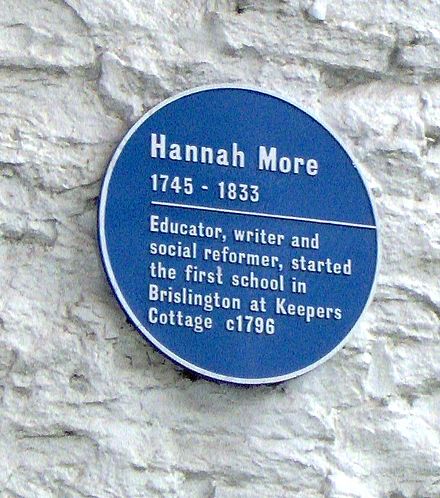

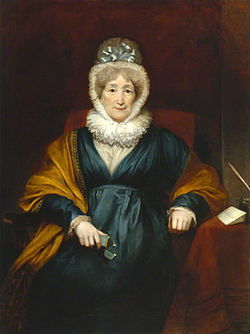
RELIGIOUS LIFE:
In 1796, subscriptions were sought in St Luke’s Church to fund weekly ‘lectures’ by visiting speakers.
On 20th May 1796 – Thomas JAMES and his close friend, John Tomkins and a Minister, John Walker, all receive the go ahead from the Bishop of Bath and Wells to begin a new non-conformist Church in Brislington. Thomas James would then build a small meeting house next to his home and next to Brislington Brook for evening meetings and worship. They might have sung hymns such as When I survey the Wondrous Cross, and Joy to the World, which by that time were popular hymns.
In England and Wales in the late 19th century the new terms “free churchman” and “Free Church” started to replace “dissenter” or “Nonconformist”. The Congregationalists went further, saying that each congregation should be independent and appoint its own ministers by a majority vote, authority being vested not in the minister or the bishop but in the people.
Robert Browne (1550–1633) was the first person to set out explicit congregational principles. ‘The meetings together … of every whole church, and of the elders therein, is above the apostle, above the prophet, the evangelist, the pastor, the teacher, and every particular elder.’ ‘The voice of the whole people, guided by the elders and the forwardest, is said [in Scripture] to be the voice of God
The two foundational tenets of Congregationalism are sola scriptura and the priesthood of believers. According to Congregationalist minister Charles Edward Jefferson, the priesthood of believers means that “Every believer is a priest and … every seeking child of God is given directly wisdom, guidance, power.”[7] This belief leads Congregationalist Christians to embrace Congregationalist polity, which holds that the members of a local church have the right to decide their church’s forms of worship and confessional statements, choose their own officers, and administer their own affairs without any outside interference
The “Nonconformist conscience” was their moral sensibility which they tried to implement in British politics.[2] The two categories of Dissenters, or Nonconformists, were in addition to the evangelicals or “Low Church” element in the Church of England. “Old Dissenters,” dating from the 16th and 17th centuries, included Baptists, Congregationalists, Quakers, Unitarians, and Presbyterians outside Scotland. “New Dissenters” emerged in the 18th century and were mainly Methodists. The “Nonconformist conscience” of the Old group emphasized religious freedom and equality, pursuit of justice, and opposition to discrimination, compulsion, and coercion. The New Dissenters (and also the Anglican evangelicals) stressed personal morality issues, including sexuality, temperance, family values, and Sabbath-keeping.
BIRTH: In 1796, Thomas and Mary JAMES have their third child together, a daughter Mary JAMES, is born, and most likely named after her mother. Sadly she would not survive childhood though as she died when she was 13.
In Weston, William GOULD’s father, Joseph GOULD, died and William took over the family cottage in The High Street according to the land tax registers. The High Street was little more than a muddy lane at that time, with a stream running along the east side. The GOULD cottage was roughly where Marks and Spencer would be in the 21st century, and on the opposite side of the street William GOULD kept a goose pen. In Ernest Baker’s interviews of 1883, William was described as having had a wooden leg, and was well-known for keeping geese, which he let out every morning to graze on the common moor land south of Regent Street. Mrs HOWELL in her interview with Baker said
“Every evening, as regular as clockwork, his geese headed by the gander, with stately tread, would march of their own accord into his pen from the open moor. “
She also mentioned that William GOULD plucked the geese, alive, as was the common practice in those days. The feathers would have been sold to make feather beds and quilts and the geese presumably grew another set of feathers. He also worked as a fisherman, because in his will of 1822 he leaves his fishing rights to his son.
Ernest Baker also reported that in the early 1800s there was no shop in Weston, but a bread-cart would come round regularly, and Hannah GOULD would buy a quantity of loaves and sell them to local people. She kept all the loaves on her table, covered with a cloth until they were sold to prevent them from getting stale.
1797
BIRTH: Thomas and Mary JAMES have their fourth child, a son, and they name him William JAMES, most likely after Thomas’ father.
1799
WORKING LIFE: Thomas JAMES takes on an apprentice William WEBB, mostly likely his wife’s nephew or other family member.
Carpentry requires training which involves both acquiring knowledge and physical practice. In formal training a carpenter begins as an apprentice, then becomes a journeyman, and with enough experience and competency can eventually attain the status of a master carpenter.
1800
BIRTH: Thomas and Mary JAMES have their fifth child together, a second daughter for the couple, who they name Elizabeth JAMES.
1801
Weston-super-Mare – Population only 100
1802
WORKING LIFE: Thomas JAMES takes on an apprentice, James Banwell.
BIRTH: Thomas and Mary have their sixth child together, a son, who they name Henry Butt JAMES (most likely including the name Butt in a nod to Mary’s maiden name).
BATH HOTEL, CLIFTON: There is evidence in the Newspaper (from auction notices) that there was a hotel in Clifton, Bristol, named Bath Hotel in 1802, and that it was still so named in 1830. Though in 1829 it was referred to as “Emeny’s Bath Hotel, Clifton Down”
1803
BIRTH: In Brislington, Thomas and Mary JAMES have their seventh child together, another daughter, who they name Rachel JAMES.
Brislington Asylum is being built at this time?
1804
MARRIAGE: In Bristol, on 18th February 1804, a young 24 year old Richard FRY marries an older, Elizabeth MAIDEN who is at that time 29 years old and as yet unmarried. They marry at St Michael’s (most likely St Michael’s on the Mount) Bristol. Despite marrying relatively late, Elizabeth either does not fall pregnant, or she has several tragic miscarriages, either way, she will spend the first 8 years of their marriage completely childless and they only have their first child together when she is really quite old to be falling pregnant. Richard devotes his time to becoming a lodging house keeper and will go on to have grand dreams of establishing a wonderful hotel.
1805
BIRTH: JOSEPH JAMES IS BORN In Brislington, towards the end of July or in very early August 1805, Thomas (now aged 37) and Mary JAMES (now aged 31) have their eighth child together, a son, who they name Joseph JAMES. He is born in Brislington and baptised on 4th August 1805.
NEWS EVENT: Well-known and influential Mad-Doctor, Dr Edward Long Fox gets married. He marries Isabella KER.
1806
NEWS EVENT: Brislington House Lunatic Asylum Opens
WORKING LIFE: In or around 1806, Richard FRY of Clifton begins to hatch a plan to speculate in the hotel trade and begins negotiations with a group of associates to help finance the build and establishment of the first hotel in Weston-super-Mare. The area is a so far relatively undiscovered area of natural beauty. Perhaps he thinks that breaks to the sea air would be good for local Bristol people who are coping with smog, and perhaps he thinks it will be good to have a stake in the area for his wife to go and take fresh air breaks there. However, it seems he did not plan to move to Weston at this time, merely contribute to the build of the hotel.
1807
NEWS: The abolition of the slave trade took place this year.
WORKING LIFE: THE HOTEL: A group of entrepreneurs, including Richard FRY, bought a burnt out old farmhouse in Weston in order to build and establish the first hotel there.
The land on which the Winter Gardens was later built, known during the 19th Century variously as ‘Hotel Field’ or later, ‘Rogers’ Field’ (colloquially ‘Rogerziz’), was purchased by Weston-super-Mare’s earliest developers – Messrs Cox, Parsley, Capell and Fry. Foundation stones for Weston’s first hotel were laid in 1807 on the site of a burned-out farmhouse, though seven years were to pass before ‘The Hotel’ became a viable business. In 1835 it would be sold to John Reeves, though with a covenant that restricted his ability to build on the Hotel Field and also dictated the field should not be ploughed. For many years the land remained in farming use with a duck pond, cabbage patch and pasture for cattle.
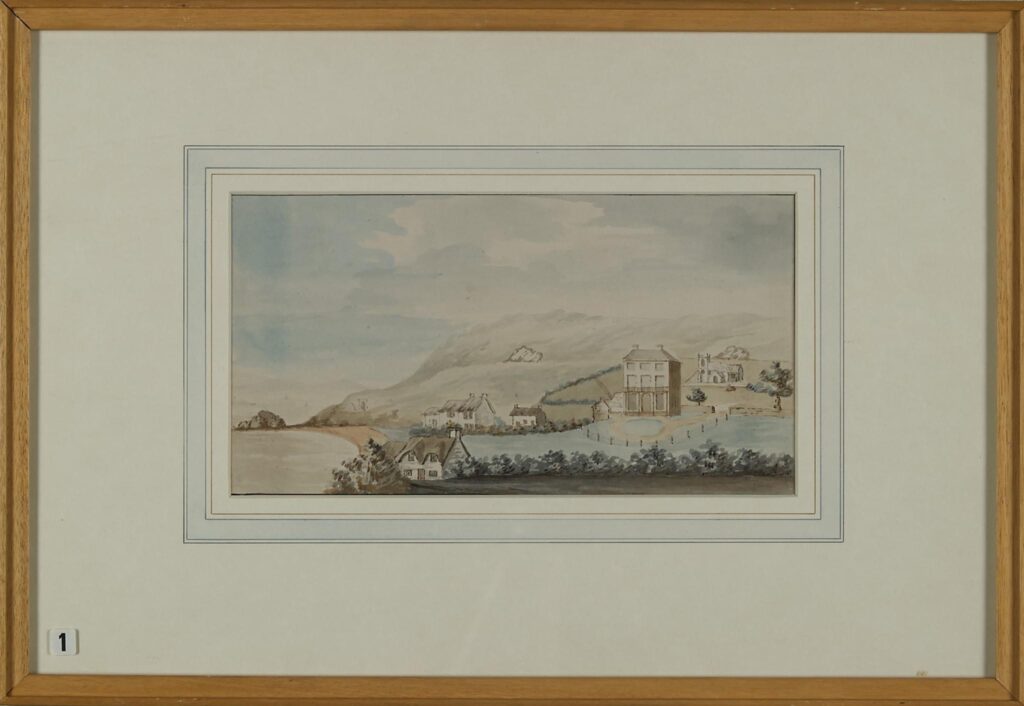
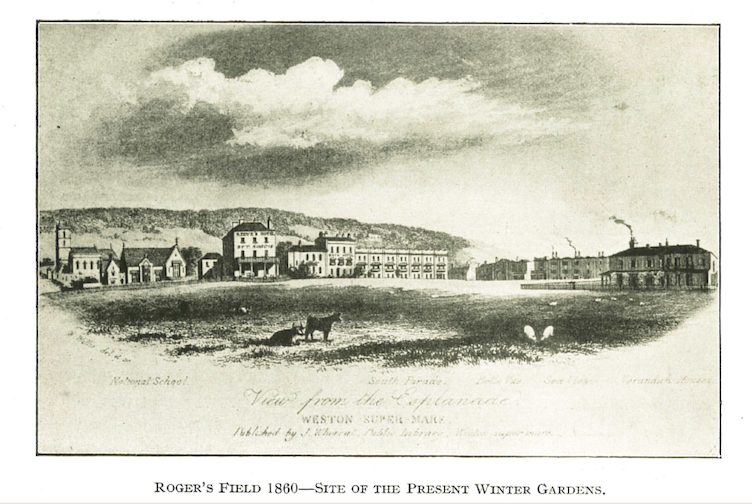
Historic England explains that Richard Parsley and William Cox, together with JP Capell and Richard Fry, were involved in the erection of the first resort hotel in Weston. Work began around 1808 on the site of a farmhouse that had been destroyed by fire in the late C18. The hotel opened in July 1810 and was leased to James Needham, a Bristol hotelier. At the time it was described as having ‘every convenience’, ‘A select Boarding Table – Neat Post Chaises – Good Stabling and lock-up Coach Houses.’ It also had facilities for making its own beer and a bathing machine. The hotel was not an immediate success, and had to close eleven months later due to a lack of custom.
“It was a financial disaster. Facilities were abysmal. Beer was not exactly on-tap, indeed an order for such refreshment necessitated a donkey ride to Worle where supply was plentiful. The hotel soon closed but in 1814 Mrs Fry decided to try again. The hotel faced south in keeping with local tradition, for nobody was then silly enough to build facing the full blast of on-shore winds. That original hotel frontage is still in place but forms the current southern side rather than main facade. Stables were added (today’s wine bar) and the business eventually flourished.”
1808
Richard Parsley and William Cox, together with JP Capell and Richard Fry, were involved in the erection of the first resort hotel in Weston. Work began around 1808 on the site of a farmhouse that had been destroyed by fire in the late C18. The hotel opened in July 1810 and was leased to James Needham, a Bristol hotelier. At the time it was described as having ‘every convenience’, ‘A select Boarding Table – Neat Post Chaises – Good Stabling and lock-up Coach Houses.’ It also had facilities for making its own beer and a bathing machine. The hotel was not an immediate success, and had to close eleven months later due to a lack of custom. It reopened in 1814 as the number of visitors to Weston increased sufficiently for the venture to succeed. This date may have coincided with the first coach services arriving from Bristol. It was called Fry’s Hotel in 1822 and Reeves Hotel by 1829 following its purchase by John Reeve. At the time, the hotel was described as a ‘large square house, pleasantly situated near the Esplanade commanding a fine view of the bay and the Bristol Channel.’ The Tithe map of 1838 shows the hotel as a detached building to the south-west of four buildings arranged around an open yard on the corner of West Street and South Parade. An illustration showing the hotel in 1815 depicts a south-east facing building with a symmetrical façade comprising a central entrance flanked with a window to either side, three windows to each of the two upper floors, and a first-floor balcony supported on columns. A painting of Weston-super-Mare dated 1842 shows the same elevation, but depicts the building with four windows on each upper floor.
DEATH: On 22nd February 1808, Thomas William JAMES, Thomas JAMES’ father, dies in Brislington at the age of 69. He left behind his wife Keturah JAMES (nee BUTT) and his sons William and Thomas, and his daughter Sarah Keturah JAMES as well as grandchildren,
BIRTH: In 1808, Thomas and Mary JAMES of Brislington, who by this time have 8 children together, the youngest of which, Joseph, is by now three years old, have a ninth child together. They have another daughter who they name Eleanor JAMES.
1809
TRAGIC DEATH: In 1809, tragedy strikes when Thomas and Mary JAMES’ daughter, Mary, aged just 13, sadly dies. Young Joseph JAMES is only four years old at this time, and his younger sister, Eleanor, is just one-year-old.
7th March 1809 – A 23 year old Ann GOULD, who was always known as Nancy, and who was the daughter of William and Hannah GOULD (nee Beacham) got married. She had been born in Weston, and in 1809, she married James BURGE in the Parish church, St John the Baptist, in Weston. They made their mark, so they must have been illiterate, and they would go on to have eight children between 1810-1829 who would all be baptised in St John’s. They would live in St James’ Street. James and his wife Nancy would go on to be involved in the original bathing machines on the beach, along with James’ brother Joseph.
1810
Weston grew swiftly in the years following the Weston Enclosure Act of 1810. The development of Weston, a now fledgling resort, was initiated by Richard Parsley and William Cox, the main proposers of the Enclosure Act of 1810. They worked with Richard FRY to build the first Hotel. As a result of the ensuing auctions of development sites, new roads, such as Oxford Street and Carlton Street, were laid out, and the first seaside villas were built.
In the early 1800s visitors rented rooms or a whole house for weeks or months at a time, from local people. The first hotel was opened in 1810 This is part of what is
now the Royal Hotel.
1811
BIRTH: Thomas and Mary JAMES have their TENTH and final child together, a son, who they name John JAMES. Joseph JAMES is six years old at this point and the brothers would grow up to work together in Weston-super-Mare and they would work in a “kindly way” with one another.
King George has become blind and insane, and his son takes over as Prince Regent.
1812
HAPPY NEWS: In or around August 1812, while living in Sion Row in Clifton and helping to run a lodging house there, Richard FRY’s wife, Elizabeth FRY, discovered she was pregnant. By this point, the couple had been married for 7-8 years and it must have been quite difficult to have remained childless to this point. Perhaps, Elizabeth who was now aged around 36 was beginning to think that she would never have a child as she was getting older. Or perhaps she had had several miscarriages by this time, and was therefore unable to let herself feel happy about this pregnancy? It is possible that that summer, Richard and Elizabeth took a break from the bustling city of Bristol and went to visit the Hotel at W-s-M since Richard FRY already had a stake in it. Maybe a lovely break to the fresh sea air was good for Elizabeth and as a result she became pregnant. Either way, her pregnancy proceeded and in April of the next year, they would have their first daughter, despite being quite old to become parents in those days.
1813
BIRTH: In Clifton, Bristol, on 28th April 1813, Richard FRY (now 32 years old) and his wife Elizabeth FRY (now 37 years old) have their first child together following 8 years of childless marriage! They have a daughter, who they name Elizabeth FRY, after her mother. At this time, Richard and Elizabeth FRY are living in a hotel in Sion Row Clifton and Richard is a Lodging House Keeper. They have their daughter baptised in Clifton in May 1813, and his occupation is stated as a Lodging House Keeper so it seems he was the proprietor of the Hotel there. Elizabeth may have been a particularly over-protective mother to her daughter. She will have been much loved no doubt, having waited so long to have a child, and if she’d previously had miscarriages, this may have made her anxious in her parenting. She may also have believed that this would most likely be her only child, since she was approaching the age of 40. She would in fact become pregnant again, for a second time, but not until three years later. Even by today’s standards, she was on the older side to be having a child at this time.
DEATH: Sadly, in this very same year, William FRY (Richard FRY’s now elderly father) died while residing in Clifton with his son Richard and his son’s wife Elizabeth Fry.
1814
James BURGE, husband of Ann ‘Nancy’ BURGE (nee GOULD) is working as a Thatcher, using reeds to thatch stone-built cottages of the village of Weston. He was also working as a fisherman, setting nets at low tide and collecting entrapped fish at the next low tide. He was a life long fisherman. His older brother (by two years), Joseph ‘old Joey’ BURGE, was a coal merchant and went on to be one of the first bathing machine proprietors. One day, Nancy BURGE would take over the bathing machines because by the census in 1861 she was listed as a bathing machine proprietor.
1815
In Weston-super-Mare the Weston Enclosure Award was completed. This award established the layout of the roads and ownership of land and it was this, together with the plentiful local supplies of building materials and the increasing popularity of the Sea Cure, which laid down Weston’s future.
In England in general, pew rental emerged as a source of controversy in the 1840s and 1850s, especially in the Church of England. The legal status of pew rents was, in many cases, very questionable.[8] Further, it exacerbated a problem with a lack of accommodation in churches, that had been noted already in the 1810s, especially in London, and in particular by Richard Yates in his pamphlet The Church in Danger (1815) with his estimate of over 950,000 people who could not worship in a parish church. St Philip’s Clerkenwell, a Commissioners’ church, was the first London church to break with pew rents.
Food supply in Great Britain was adversely affected by the Corn Laws (1815–1846). The Corn Laws, which imposed tariffs on imported grain, were enacted to keep prices high in order to benefit domestic producers. The Corn Laws were repealed in the early years of the Great Irish Famine.
1816
HAPPY NEWS: In or around April 1816, Elizabeth FRY had the happy news of being pregnant with a second child, despite being almost 40 years old. Perhaps the family had visited Weston-super-Mare and enjoyed the sea air because soon, Richard FRY would make plans to take over the hotel and move his family to the coast.
MARRIAGE: On 28th July 1816, at St John the Baptist Church in Bristol, Thomas and Mary James’ eldest son Thomas Richard James, now aged 22, marries a young woman named Julia Ann CAMPLIN who was from Bristol. She was two years older than Thomas, aged 24. Thomas takes his young wife home to live in Brislington and Julia becomes pregnant with their first child immediately after they marry. So by September, they had the happy news that their first child was on the way.
BIRTH: On Christmas Eve, 24th December 1816, when Richard and Elizabeth FRY’s young daughter was by now four years old, and despite Richard FRY being 35 years old and his wife being even older at 40 years old, they had their second child together, finally a son. Richard FRY must have been overjoyed to have a son, especially as a Christmas present, since he waited so long to have one. He had now been married for around 11 years and not having a son in those days must have been quite hard for him. They named the baby, Richard, after his father.
1817
HAPPY OCCASION: In Clifton, Bristol, Richard and Elizabeth FRY have their son baptised on 19th January 1817 at St Andrew’s.
BIRTH & TRAGIC DEATH: In April 1817, in Brislington, Thomas (the eldest son of Thomas and Mary) and his young wife Julia Ann James, have their first baby together. They name the baby Thomas Charles James (most likely after Thomas’ own father before him) but sadly, just two months later, the baby dies and they have a burial for their young infant son on 21st June 1817. Julia gets pregnant for a second time immediately, and by July or August, they know they are to have a second baby. It’s not clear why the baby died, but of note, in the Bristol area, an epidemic of contagious fever broke out in 1817 and continued for the next two years.
WORKING LIFE: In 1817, Richard FRY begins to make plans to take over the Hotel at Weston-super-Mare and to move his small family there. Perhaps he believes that the sea air is medicinal and to thank for the successful pregnancies his wife had and perhaps he thinks even more children might be possible if the family move to the coast.
1818
WORKING LIFE: By 25th April 1818, Richard and Elizabeth FRY were now living in Weston-super-Mare and they advertised for custom and sought new visitors, saying that they had taken over the Hotel there.
You can see a virtual experience of the Hotel and how close it was to the beach and to Knightstone HERE.
The Hotel reopened in or around 1814-1818 as the number of visitors to Weston increased sufficiently for the venture to succeed. This date may have coincided with the first coach services arriving from Bristol. It was called Fry’s Hotel upon re-opening.
BIRTH & BAPTISM: In Brislington, in February 1818, Thomas (24) and Julia James (25) (the eldest son of Thomas and Mary James and his young wife) have their second child together. This birth follows the sad death of their first son who had passed away aged just 2 months. They have another son, and they have him baptised in the church in Brislington on 1st March 1818, naming him Henry James. Julia gets pregnant immediately again.
BIRTH: In late December 1818, Julia James, the wife of Thomas and Mary’s eldest son Thomas, gives birth for a third time, which is the second time in that very same year. She has another son, and they name him Thomas James (the same as their first son who died (most likely because the name Thomas was so important to them, being the name of the baby’s father and grandfather). However, it seems that giving birth for a second time in just one year may have been too much for Julia because her health would deteriorate quickly.
1819 (Was there a nasty illness near Bristol this year?)
OPENING: In 1819, in Weston-super-Mare, the second hotel in Weston was opened. It was originally called “The Mason’s Arms” and then later, “The Bath Hotel”. It was just next door to the main hotel. “A second hotel opened across the road in 1819 – The Bath (later it became The Imperial and ran as a public house for many years, later still it was run by successful gold medalist water polo player and swimmer Olympian Paulo Radmilovic – and in 2020 it is now a Mediterranean Restaurant called Olea).”
A SERIES OF TRAGIC DEATHS: In Brislington, in 1819, tragedy struck the JAMES family.
In February 1819, just two months after giving birth to her third child, Julia James sadly died at the age of just 27 years. She is recorded in the burial register as Julia ‘Maria’ James however, so this is not completely proven. But assuming this was in deed the same Julia, she was buried in Brislington on 12th February 1819. She left her husband, Thomas, a lone father with his two remaining infant sons, Henry who is only just coming up to one year-old, and baby Thomas, just two months old. Thomas would undoubtedly have needed to get help with the babies. Perhaps his mother Mary helped with looking after them, however there was more tragedy to come.
Just two months later, in April 1819, Thomas’ baby son, Thomas, died too, at the age of only four months. He was buried in the church in Brislington on 28th April 1819.
Then, just a day or so later, Thomas and Mary James’ 11-year-old daughter, Eleanor, the younger sister of their eldest son Thomas James, ALSO died. Her other big brother Joseph was just 14 years old at the time and he must have felt the loss. Eleanor’s youngest brother, John JAMES, the baby of the family, was only 8 years old at the time of her death and as his big sister, she must have been a great loss to him too.
As if these losses for the family weren’t already bad enough, in July, just a few months after losing his wife Julia, then their baby son Thomas too, and then his younger sister Eleanor, Thomas’s only other surviving child, his one-year-old son Henry, ALSO then died! He was only 16 months when he was also buried in Brislington on 23rd July 1819. Thomas, and his parents Thomas and Mary, must all have been devastated. It’s unclear why so many died, however, in Bristol there was an epidemic of contagious fever between 1817 and 1819.
Perhaps the losses for Thomas and Mary this year were so great that they felt unhappy in their family home, because later this same year, their home would be advertised ‘To Let’.
HOUSE & LAND: In November of 1819, Thomas JAMES advertises ‘To Let’, a large home in Brislington, with 4 sitting rooms, 8 bedrooms, numerous out houses and 3 acres of land. He also says that the tenant will be entitled to a Pew in the church. So where did Thomas and his wife Mary and their remaining children who were still living at home, go to live I wonder?

November 1819 Advertisement in The Bristol Mirror for a family residence in Brislington which Thomas JAMES appears to own.
1820
In 1820, the ‘Mad’ King George dies and his son, George IV takes over the throne. He is known as the “First gentleman of Europe”. He had a love of art and architecture but his private life was messy. He was a great wit, but also considered a buffoon. When he died in 1830 it was considered a national relief.
In Weston, building works begin at Knightstone Island. The idea of a spa bath was still very popular. Howe’s baths opened on Knightstone in July 1820. Lodgings were built for the invalids as well as a refreshment room and reading room. Knightstone was an island and bathers were ferried over by local boatman, Aaron Fisher. Later a low causeway was built to the island. Sea bathers used either bathing machines during high tide from the beach. There was a ladies-only location at Anchor Head, and from 1820 people used the bath house and pool on Knightstone Island.
They comprised hot and cold salt water baths and a two-storey house, part used as lodgings for invalids, the other part for public tea and coffee rooms and a reading room. In those days the price of a hot bath was three shillings (15p) and a cold bath, one shilling (5p). At this stage Knightstone was still disconnected from the mainland at high water. so bathers were ferried over while coal boats would unload in the shelter of the Island. Over the next five years several additions to the buildings on the island such as towers and turrets were made.
WORKING LIFE: In Weston-super-Mare, probably sensing that HOWE’s baths at Knightstone would attract custom and visitors to Weston, Richard FRY makes plans to refit the hotel.
Also in the 1820s, there were trees planted on Weston Hill by the Lord of the Manor to form a private game reserve. From the top it was possible to enjoy splendid vistas as far as Exmoor and Wales. These would later become beautiful ‘drives’ and walks through Weston Woods for later tourists to the area.
1821
HOUSE & LAND: On 28th June 1821, Thomas JAMES sells off some land at Keynsham.
1822
PUBLICATION: The first holiday guide for Weston-super-Mare. 1822
Weston’s first guide book for visitors was written in 1822. It paints a vivid portrait of the village at that time. The population was then 735. One hotel, two inns and a number of lodging houses catered for visitors. There was a Methodist chapel, in addition to the parish church and a post office. Weston was described as a “penny post from Bristol”, the letters being brought by carrier every evening from May to November and every Monday, Wednesday and Friday morning during the winter. There was little organised entertainment – a billiard table, a reading room and two pleasure boats for hire. Visitors would have read, sketched, walked and conversed. Dances would have been held at the Assembly Rooms.
NEWS EVENT: Richard Fry announces in the paper that he has refitted The Hotel. He also advertises that four horse coaches go to and from Bristol every day of the week.
“In 1822 a third hotel – The Plough – opened on the far side of Roger’s Field (today’s Italian Gardens and Town Square).”
HOUSE & LAND: In 1822, Thomas JAMES advertises in the newspaper again, this time ‘To Let’, 40 (?) Acres of land in Brislington available for immediate possession.
MARRIAGE: On 9th April 1822, at St Mary’s Church in Nether Stowey, a picturesque village in Somerset, a young labourer named William JONES marries Hannah WHEDDON (My GGGG Grandparents). Three years later, they would have a son, Sidney JONES.
8th June 1822, William GOULD has died and is buried in St John’s. His will was proved on 27th September 1822 and his widow Hannah was his executor. He leaves his fishing rights at Bearn Beck (Birnbeck) along with his nets, rods, and fishing materials, to his son, William GOULD the junior. Fishing rights were prized possessions of the local fisherman.
1823
NEWS EVENT: THEFT! A number of fruit trees are stolen from a garden in Brislington by someone with a size 13 inch shoe. This took place on or around 1st April 1823. On 1st June (?) 1823 Thomas JAMES (now aged 55) reports in the newspaper that he’s offering a 10 guinea reward for information relating to the theft of several fruit trees from a farm in Brislington.
HAPPIER TIMES: Thomas Richard James, having spent three or four years grieving for and lamenting the loss of his young family, his wife Julia and their three sons, now meets another young woman, named Ann Hayward Scudamore.
On 1st December 1823, at St Augustine, Bristol, Thomas Richard (now aged 29) and Ann Hayward (aged 27) marry. Their marriage is witnessed by Thomas’ brother William James and sister Rachel James. However, Ann Hayward would not get pregnant straight away so they perhaps had an anxious wait to see if he would have any further children, or perhaps he was worried about his new wife and any new babies.
In Weston, John Hugh Piggott-Smith becomes Lord of the Manor. Though many in the family were quite bonkers, John had vision. He inherited the manorial lordship of Weston-super-Mare on Christmas Day 1823, following the death of the Rev. Wadham Pigott. The energetic young squire encouraged village children to plant trees on the hillside, initially to create a private game reserve but, once trees began to mature, he threw this woodland open to public wandering. Two of his original gate lodges are still with us, one in private occupation in Worlebury Hill Road and the other serving food in castellated splendour at the Kewstoke end of the Toll Road. He replaced the crumbling Medieval St John’s with a new parish church (helped by a substantial grant from Wadham) and greatly enlarged his manorial residence at Grove House most of which was subsequently destroyed during the Second World War. With assistance from far-sighted agents he, along with a new breed of local entrepreneurs, began to change Weston from a sleepy village of little consequence into a town of rising middle-class pretention and expectation. It was the dawning of tourism
1824
PHILANTHROPY: Richard FRY, in his role as one of the Town Commissioners, contributed to the re-building of the parish church
In December 1824 the Rev Thomas Pruen took over the island and built a low causeway and an outdoor swimming pool that could be replenished by the tides.
“Bath and lodging houses were built on Knightstone Island and in 1824 the Rev Thomas Pruen erected a low causeway.”
1825
BIRTH: In Brislington, Thomas Richard James and his new wife Ann Hayward welcome their first child into the world together, this time it is a healthy baby daughter for Thomas, who they name Mary Ann after his mother. She was strong and would go on to live a good long life however, she may have been over-protected by her father, as she seems to have grown up very independent, strong-willed and rebellious (at the age of fifteen she would be found guilty of larceny and she would remain a spinster all her life!). Soon, after having baby Mary, Ann would be pregnant again.
BIRTH: In Nether Stowey, a small, beautiful and picturesque rural village in Somerset, a young couple named William JONES (who was a labourer) and Hannah JONES (nee WHEDDON) have a baby son, who they name Sidney JONES. On 10th July 1825, he is baptised at St Mary’s Church in Nether Stowey, where his parents had married three years earlier. Sidney’s parents would go one to have more children, but sadly, three of them would die in infancy or childhood so the family knew a lot of grief and loss.
1826
BIRTH: In Weston-super-Mare, in 1826, a young couple named Richard JONES, a labourer, and Mary JONES (nee GOULD) have a daughter who they name Hannah JONES.
1827
17th May 1827 – At around 50 years old, Joseph BURGE married a widow Mary GAD at St John the Baptist.
HOUSE & LAND: Thomas JAMES advertises in the newspaper again for his large house which is ‘To Let’. It comes with a coach house, a 3 Acre orchard and 3 acres or so of pasture land too.
Nonconformists in the 18th and 19th century claimed a devotion to hard work, temperance, frugality, and upward mobility, with which historians today largely agree. A major Unitarian magazine, the Christian Monthly Repository asserted in 1827:
Throughout England a great part of the more active members of society, who have the most intercourse with the people have the most influence over them, are Protestant Dissenters. These are manufacturers, merchants and substantial tradesman, or persons who are in the enjoyment of a competency realized by trade, commerce and manufacturers, gentlemen of the professions of law and physic, and agriculturalists, of that class particularly who live upon their own freehold. The virtues of temperance, frugality, prudence and integrity promoted by religious Nonconformity…assist the temporal prosperity of these descriptions of persons, as they tend also to lift others to the same rank in society
The emerging middle-class norm for women was separate spheres, whereby women avoid the public sphere—the domain of politics, paid work, commerce and public speaking. Instead they should dominate in the realm of domestic life, focused on care of the family, the husband, the children, the household, religion, and moral behaviour.[14] Religiosity was in the female sphere, and the Nonconformist churches offered new roles that women eagerly entered. They taught Sunday school, visited the poor and sick, distributed tracts, engaged in fundraising, supported missionaries, led Methodist class meetings, prayed with other women, and a few were allowed to preach to mixed audiences
Parliament had imposed a series of disabilities on Nonconformists that prevented them from holding most public offices, that required them to pay local taxes to the Anglican church, be married by Anglican ministers, and be denied attendance at Oxford or degrees at Cambridge.[16] Dissenters demanded removal of political and civil disabilities that applied to them (especially those in the Test and Corporation Acts). The Anglican establishment strongly resisted until 1828
1828
HOUSE & LAND: Thomas JAMES again advertises in the newspaper ‘To Let’ his home in Brislington. It is described as a convenient family house within a moderate walk of Bristol, with suitable offices, garden, orchard and a field.
WORKING LIFE: In 1828, Richard FRY leaves Fry’s hotel, it is taken over by James REEVES and becomes Reeve’s Hotel. The FRY family move in to the Bath Hotel which is just across the street at 8 South Parade and then they move into a cottage called Myrtle Cottage which was just next door at 7 South Parade.
The Sacramental Test Act 1828 (9 Geo. IV, c. 17) was an Act passed by the British Parliament. It repealed the requirement that government officials take communion in the Church of England. Sir Robert Peel took the lead for the Tory government in the repeal and collaborated with Anglican Church leaders
At Knightstone: Between 1828 and 1833 Dr Long Fox had a new medicinal bath house built, alongside three lodging houses on Knightstone Island. Joseph JAMES worked with his brothers and fathers on the project.
The spa was open to everyone – from the upper classes to people with mental health problems.
1830
Clifton: A cook named William Fell who was working at The Bath Hotel, Clifton, attempted to take his own life by shooting himself in the head. He died a week later.
In 1830, King George, who had been widely thought to be a buffoon, died and William IV was crowned King. When he was a young Prince William, he had served in the Navy for ten years, so became known as the “Sailor King”. Before he’d ascended to the throne, he’d been living with an Actress named Mrs Jordan and they’d had ten children together. But when Princess Charlotte had died, he’d had to marry in order to secure the succession to the throne, so in 1818 he’d married Adelaide of Saxe-Coburg. They’d had two daughters, but they didn’t live. He hated pomp and ceremony, and he’d wanted to dispense with the coronation. The people loved him because he was considered to be lacking in pretension. During his reign, slavery would be abolished in the Colonies.
In 1830 most Americans were, at least in principle, opposed to slavery. The problem was how to end it, and what would become of the slaves once they were free. In the 1830s there was a progressive shift in thinking in the North, from gradual emancipation and resettlement of freed blacks in Africa (see American Colonization Society), to immediatism: freeing all the slaves immediately and sorting out the problems later.
WORKING LIFE: In 1830, Edward Long Fox purchased Knightstone Island to establish a therapeutic spa with a range of hot, cold and chemical baths.
In Sept 1830 the island was purchased by Dr Edward Long Fox (1761-1835) a prominent Quaker physician in Bristol and a true pioneer of the humane treatment of the insane. In September 1830 Dr Edward Long Fox of Bristol purchased Knightstone. This doctor was a pioneer in the humane treatment of the insane and a lot of development took place on the island, including an exercise courtyard for patients and a new elegant bath house. This fine building survives today. At this time the causeway was heightened using granite from a quarry near Falmouth which belonged to Dr Fox’s father, Dr Joseph Fox, and was carried round Lands end in ships belonging to a cousin G.K.Fox. Granite was also used for the characteristic Cornish bastions protecting the island from the sea. Contemporary reports state that Dr Fox spent £20,000 or more on the island.
In 1830, he brought his humane and compassionate treatment methods of the insane to Weston-super-Mare. Although he was approaching 70, he continued to dedicate his life helping the town’s patients and created a therapeutic spa, with hot and cold baths at Knightstone Island.
His approach became the accepted practice within the Victorian asylum system, largely thanks to the success of Brislington House and other private institutions.
Dr Long Fox has been immortalised in Weston – his name was given to the centre helping people with mental health conditions at Weston General Hospital – and there is a blue plaque on Knightstone Island.
Joseph JAMES moved to Weston-super-Mare to begin work for Dr Fox on the Causeway to Knightstone Island and the development of the buildings. His father Thomas JAMES was by this time quite old, and was likely now taking a back seat in the family business (Three years from now he would pass away). “When Dr Fox acquired Knightstone he improved the causeway and added even better facilities with much improved accommodation.” Joseph James came to Weston to work for Dr Fox to build the causeway (?).
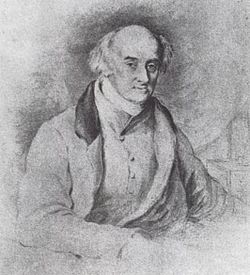
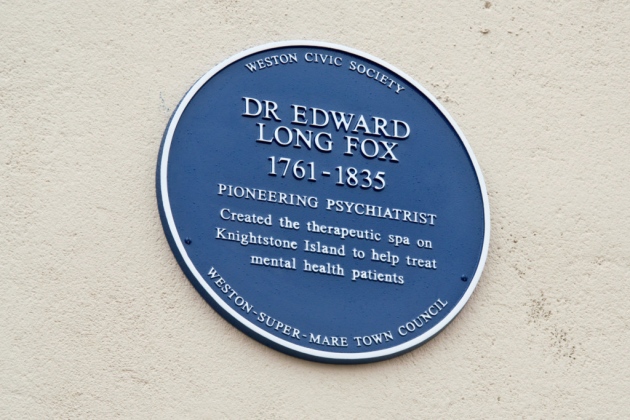
1830s – ‘Ragged’ Schools were introduced in London, to provide education for poor children.
1831
DEATH: In Brislington, on 30th September 1831 Thomas JAMES died at the age of 65 in Brislington. He was buried in St Luke’s Church Graveyard in Brislington. His grave stone reads:
“THOMAS JAMES Died Sep’r 30th 1831 Aged 63 Years. A man universally belov’d and esteemed by a numerous circle of friends and his lamented family. Also of MARY Wife of the above THOMAS JAMES Died Feb’y 10th 1842 Aged 74 Years. Also Elizabeth Pearson, Daughter of the above.”
__________________________________________________________________________________________________
29th October 1831 – The Bristol Riots: The Queen Square Riots took place over three nights. A protest about voting rights. In 1830 only 6000 out of the population of 104,000 had the right to vote. 500-600 young men took part in the riots and buildings were looted and damage was done. The Clifton Bridge building project was halted.
1832
The Reform Act was passed, this extended the franchise to the middle-classes on the basis of property qualifications. Women were explicitly prohibited from being able to vote nationally and locally in the 1830s by the Reform Act 1832 and the Municipal Corporations Act 1835 Women’s suffrage, the fight for the right to vote, began to rise over the coming years.
MARRIAGE: Shortly after the death of his father in 1832, Joseph JAMES, who by now was aged 27, married Richard and Elizabeth FRY’s only daughter, Elizabeth FRY (who by now was aged just 20). They married in Bristol, at St James. I’m not sure why they married there and not in Weston-super-Mare, but Richard Fry, Elizabeth’s father was in attendance as he signed the register as a witness. Richard (now aged around 53) and Elizabeth (now aged 56) then welcomed Joseph to live with them.
Joseph went to live with his new wife Elizabeth, her parents, and her younger brother Richard who is by now 16. They all live together in Myrtle Cottage, next door to The Bath Hotel in W-s-M. Elizabeth, the young bride, does not get pregnant immediately, and perhaps her mother may have worried that she too would have trouble conceiving and having children. However, she needn’t have worried too much because although two years would pass, young Elizabeth would eventually get pregnant and then she would go on to have 13 children! Grandmother Elizabeth must have enjoyed having so many children arrive into the house, having struggled to have her own so many years ago.
FAMILY LIFE: Richard and Elizabeth FRY are living in Myrtle Cottage with their daughter and 16-year-old son Richard. Elizabeth’s new husband Joseph JAMES now lives there along with them.
LITERATURE: Robert Blincoe (c. 1792–1860) was an English author and former child labourer. He became famous during the 1830s for his popular autobiography, A Memoir of Robert Blincoe, an account of his childhood spent in a workhouse. However, there are some doubts about whether this detailed observation of Blincoe’s early life can be considered ‘autobiography’. According to John Waller, in his book The Real Oliver Twist, his life story was told to a John Brown, who wrote the manuscript of a biography of Blincoe before committing suicide later the same year. But Brown had given his manuscript to a friend, Robert Carlile, who published the resulting book, A Memoir of Robert Blincoe, in five episodes in his magazine The Lion in 1832.
Robert Blincoe, my great-great-great-grandfather, was a workhouse orphan and illegitimate. His life story was serialised in the Lion, a radical newspaper, in 1828 and republished in book form as The Memoirs of Robert Blincoe in 1832. The memoir became a cause célèbre when it was quoted in parliament (where Dickens worked as a reporter), and the focus of a political campaign. Robert, who had been disabled by his upbringing, even appeared on political posters of the 1830s, beneath a slogan borrowed from the abolitionist movement: “Am I Not a Man and a Brother?” Dickens would have known of The Memoirs of Robert Blincoe, but the identification of Oliver with Robert rests chiefly upon the opening chapters of the two books.
Waller wonders why Robert proved so resilient. The reason for Oliver’s incorruptibility lies in the secret of his birth: he is of a good family and his blood is true. Polanski abandons this element of the novel, perhaps out of scepticism, but Waller shows that belief in good breeding was widespread in Dickens’ age. And once Waller has raised the issue, he uses it to shine a light on Robert’s character. Thanks to workhouse rumours, Robert grew up believing he was the son of a priest. Throughout his childhood, he was known as either “Saint” or “Parson”, and never heard the name Robert Blincoe until he received his indenture papers as an adult. Waller argues that this belief, though mistaken, explains Robert’s unusual sense of self.
At Knightstone: From the Bristol Mirror,11 August, 1832
“Dr Fox of Brislington is engaged in erecting a spacious building on one Knightstone rock, at this place, for the purpose of introducing fresh and salt water,hot and cold vapour and shower, sulphur and every description of medicated baths”
1833
Slavery was abolished in the Colonies.
1834
HAPPY NEWS: In or around March 1834, Elizabeth JAMES, Joseph’s young wife, most likely discovered she was pregnant with their first baby. They had been married for two years by this time.
BIRTH: On 10th October 1834, Joseph and Elizabeth JAMES have their first child together, a daughter, Elizabeth JAMES, who they name after Elizabeth’s mother, Elizabeth FRY. The young family are all living at home in Myrtle Cottage with Richard and Elizabeth FRY. The very next month after Elizabeth gave birth, she became pregnant again.
BIRTH: On 8th August 1835, Joseph JAMES wife, Elizabeth JAMES, gives birth to their second child. They have a son, who they name Richard JAMES after Elizabeth’s father. They already have a baby daughter Elizabeth and she is only 10 months old by the time they have their second child. Only three months later, Elizabeth would get pregnant again.
Poor Law Amendment Act – Separating Somerset into 17 Poor Law Unions (each with own workhouse)? The national implications of the Act was intended to curb the cost of poor relief and address abuses of the old system, prevalent in southern agricultural counties, by enabling a new system to be brought in under which relief would only be given in workhouses, and conditions in workhouses would be such as to deter any but the truly destitute from applying for relief.
From an advertisement of 1834
“Every kind of Bath will be found here including a ‘plunging bath’ formed on a shelving rock with a small breakwater. The ladies and gentleman’s baths are apart, each having their dressing room and toilette.”
1835
NEWS WORTHY DEATH: Well-known pioneering Mad-Doctor Edward Long Fox dies. He had written his will and testament on 24th March 1835 and he bequeathed Joseph JAMES £100 in his will. This was quite a substantial amount of money in those days. Joseph was his Superintendent at the baths at Knightstone at this time, and he had been in the employ of his father Thomas JAMES and his brothers, while completing the works at Knightstone. Dr Fox specifically mentions his choice to leave him this money is in recognition of his fidelity and services, and also as a token of the high respect and great affection for Joseph’s late father Thomas JAMES, so they must have had a close relationship of some kind.
1836
BIRTH: On 3rd July 1836, Joseph JAMES’ wife Elizabeth JAMES gives birth again at Myrtle Cottage to their third child. The couple have another daughter, who they name Mary Elizabeth JAMES, after Joseph’s mother Mary JAMES, and Elizabeth being the name of both Elizabeth herself and her own mother. They celebrate her baptism on 30th July 1836 and Joseph’s profession of Builder is entered onto the registry. After this, they have a short break in children and Elizabeth doesn’t get pregnant again for a year.
Charles Dickens publishes The Pickwick Papers about the Pickwick club travelling around the UK by Coach. It was a publishing phenomenon. It stimulated people around the UK to start their own Pickwick clubs. The Pickwick Papers is a sequence of loosely related adventures written for serialization in a periodical. The action is given as occurring 1827–28, though critics have noted some seeming anachronisms.[4] For example, Dickens satirized the case of George Norton suing Lord Melbourne in 1836.[5]
The novel’s main character Samuel Pickwick, Esquire is a kind and wealthy old gentleman, the founder and perpetual president of the Pickwick Club. He suggests that he and three other “Pickwickians” should make journeys to places remote from London and report on their findings to the other members of the club. Their travels throughout the English countryside by coach provide the chief subject matter of the novel.[6]
Non-conformists: The marriage question was settled by Marriage Act 1836 which allowed local government registrars to handle marriages. Nonconformist ministers in their own chapels were allowed to marry couples if a registrar was present. Also in 1836, civil registration of births, deaths and marriages was taken from the hands of local parish officials and given to local government registrars. Burial of the dead was a more troubling problem, for urban chapels rarely had graveyards, and sought to use the traditional graveyards controlled by the established church. The Burials Act of 1880 finally allowed that.
1837
King William IV died, and it was the custom to hang black crepe over buildings as a sign of mourning. John NEATHWAY, who was a tailor and husband to Hannah NEATHWAY (nee GOULD), one of the daughters of William and Hannah GOULD, was paid £1 10s to provide black cloth to hang on St John’s Church in Weston. They were living nextdoor to Hannah’s mother, also Hannah GOULD, who had her young granddaughter Maria JONES living with her by 1841 acting as a housemaid.
Queen Victoria ascended to the throne. She was the only child of Victoria of Saxe-Coburg and Edward Duke of Kent, fourth son of George III but the throne she inherited was weak and unpopular.
HOUSE & LAND: In 1837, a man named Benjamin Brice, a local builder in W-s-M, builds Victoria Cottage at 7 South Terrace in Weston-super-Mare. The house is originally built for a man named Arthur Day. The house would go on to be owned by Joseph JAMES in around 11 or 12 years-time. Benjamin Brice owns the property from 1837-1844. Then Arthur Day owns it from 1844-1849, however, he defaults on the mortgage and Joseph JAMES then buys the property from him for £320 to settle the debt.
HAPPY NEWS: In around July 1837, Joseph and Elizabeth FRY conceive their fourth child together and she likely learns that she’s pregnant again in around August, when they are celebrating their son’s 2nd birthday. The couple already have three very young children to care for by this time, Elizabeth (2 ½ nearly 3), Richard (Only just 2) and Mary (Just turned 1).
Charles Dickens wrote Oliver Twist (in part to reflect needs for social reform and conditions for the poor). Oliver Twist; or, the Parish Boy’s Progress is Charles Dickens‘s second novel, and was published as a serial from 1837 to 1839 and released as a three-volume book in 1838, before the serialization ended. The novel may have been inspired by the story of Robert Blincoe, an orphan whose account of working as a child labourer in a cotton mill was widely read in the 1830s
On the tithe map of 1837 Hannah GOULD is a landowner of plot 494, most likely inherited from her husband in 1822 when he died leaving her a widow, and the plot is occupied by Simon PALMER who was a shoemaker.
1838
BIRTH: On 28th March 1838, Joseph JAMES’ wife Elizabeth JAMES gives birth to their fourth child together. This time, a son, who they name Thomas Richard JAMES. They name him after Joseph’s late father, Thomas JAMES and give him the middle name Richard after Elizabeth’s father and brother. They are still all living together, along with Elizabeth’s father and mother, and her younger brother Richard Fry Jnr, at Myrtle Cottage. Joseph’s occupation of ‘Carpenter’ is entered onto his new son’s baptism certificate. There is a gap of around a year again where Elizabeth does not get pregnant.
Nicholas Nickleby or The Life and Adventures of Nicholas Nickleby is a novel by Charles Dickens originally published as a serial from 1838 to 1839. It was Dickens’s third novel. The story centres on the life and adventures of Nicholas Nickleby, a young man who must support his mother and sister after his father dies.
1839
HAPPY NEWS: In around March 1839, Elizabeth and Joseph JAMES learn that she is pregnant again. This will be their fifth child together.
HOUSE & LAND: In 1839, Joseph JAMES and his wife Elizabeth, and their four young children, all move out of Elizabeth’s parents’ home and move over to Knightstone Island. Joseph JAMES is to run the Baths there at Knightstone. They live in a “small dwelling house” near to the main Bath House. It has two sittings rooms, four bedrooms, and an underground kitchen and offices etc.
You can make a virtual visit to the Baths at Knightstone HERE.
BIRTH: On 13th November 1839, Joseph JAMES’ wife, Elizabeth JAMES gives birth to the couple’s fifth child, another son, who they name Joseph Pearson JAMES (after Joseph himself and Pearson coming from another family connection – possibly his older sister’s husband?).
1840
At Knightstone: From an advertisement of 1840
“There are also hot and cold shower baths, dry hot and vapour baths, either medicated with sulphur, iodine, chlorine or otherwise, with apparatus for the administration of the douche. There is a reading room overlooking the sea where the terms for the bathing will be found and where the London and other papers as well as periodicals may be seen.”
Queen Victoria married her cousin Albert of Saxe-Coburg. He exerted tremendous influence over his wife and was the virtual ruler of the country. He was a pilar of respectability and he introduced art and culture and the Christmas Tree!
BIRTH: Joseph and Elizabeth JAMES have another child, their sixth, and it is another son, who they name Benjamin. By around October of this same year, Elizabeth would be pregnant again.
SCANDAL: In Somerset (possibly Brislington), a young fifteen-year-old Mary Ann James, the eldest daughter of Thomas and Ann James and granddaughter of Thomas and Mary James, commits a crime! She is found guilty of larceny and sentenced to two weeks’ imprisonment.
TRANSPORT: The Great Western Railway opened the 11 1⁄2-mile (19 km) section of the railway service from Bristol to Bath. It opened on 31 August 1840.
The Old Curiosity Shop is one of two novels (the other being Barnaby Rudge) which Charles Dickens published along with short stories in his weekly serial Master Humphrey’s Clock, from 1840 to 1841. It was so popular that New York readers stormed the wharf when the ship bearing the final instalment arrived in 1841.[1] The Old Curiosity Shop was printed in book form in 1841.
The plot follows the life of Nell Trent and her grandfather, both residents of The Old Curiosity Shop in London.
Queen Victoria read the novel in 1841 and found it “very interesting and cleverly written”
The events of the book seem to take place around 1825. In Chapter 29, Miss Monflathers refers to the death of Lord Byron, who died on 19 April 1824. Nell Trent, the novel’s main character. Portrayed as infallibly good and angelic, she leads her grandfather on their journey to save them from misery. She gradually becomes weaker throughout the journey, and although she finds a home with the help of the schoolmaster, she sickens and dies before her friends in London find her. Nell’s grandfather, Nell’s guardian. After losing both his wife and daughter, he sees Nell as the embodiment of their good spirits.
Reformatory schools were penal facilities originating in the 19th century that provided for criminal children and were certified by the government starting in 1850. As society’s values changed, the use of reformatories declined and they were coalesced by an Act of Parliament into a single structure known as approved schools. Although similar in some of their practice, industrial schools were intended to prevent vulnerable children becoming criminal.[4]
There was a perceived rise in juvenile delinquency in the early 19th century; whereas in a rural economy very young children could gain paid employment doing tasks such as bird scaring and stone gathering these opportunities were not available in the cities. Youngsters were very visible on the streets. In 1816, Parliament set up a ‘Committee for Investigating the Alarming Increase in Juvenile Crime in the Metropolis’, in 1837 the writer Charles Dickens published Oliver Twist a story about a child involved in a street gang. and in 1847 it was recognised in the Juvenile Offences Act of 1847, that children under 14 should be tried in a special court not an adult court.[5] Begging and vagrancy was rife, and it was these low level misdemeanours that caused the magistrates to send vulnerable youngsters to industrial schools to learn to be industrious, and learn skills that would make then more employable.
In 1840, Victoria Buildings were the first terrace of houses to be built on the seafront at Weston. The houses were originally built for wealthy residents but were soon used as lodgings for visitors to the resort. Today they are known as Knightsone Road, the best preserved building is 18 Knightstone Road. You can see what they look like today HERE and make a virtual visit HERE.
1841
CENSUS YEAR
CENSUS ENTRY: The 1841 census shows Joseph JAMES aged 31, listed as a Builder, living with his wife Elizabeth, aged 27, and their children Mary (4), Thomas (3), Joseph (2) and Benjamin (1). Their two eldest children are not listed. This makes me wonder whether they have been sent off to school?
CENSUS ENTRY: The 1841 census shows Richard and Elizabeth FRY are still living in Myrtle Cottage. It shows that Richard is a Lodging House Keeper and he owns number 5, and also number 8 (The Bath Hotel) at South Parade. They are living there with their son Richard, who is now aged 22, and who is also a Carpenter like his brother-in-law Joseph JAMES.
CENSUS ENTRY: The 1841 census shows that a young 15 year old ‘Sydney’ JONES is a shop apprentice for a ‘Cordwainer’ (shoe maker crafting leather) business run by Lawrence COOMBES and his family in Weston-super-Mare. If this was in deed my GGG Grandfather Sidney JONES then he was now living about 25 miles north of Nether Stowey, the small village in which he was born and raised and he was learning a trade, even though he would go on to become a Tailor, Draper and Milliner.
CENSUS ENTRY: The widow Hannah GOULD (now aged 70) is living in a cottage in The High Street, with her granddaughter, Maria JONES (aged 13) who was the daughter of Richard and Mary JONES (nee GOULD) and who would go on to marry a young Sidney JONES in around 5 years time. Mary, Maria’s mother, was William and Hannah GOULD’s second daughter. Maria is listed as Hannah’s servant on the census so at 13 she was in service to her grandmother. Living next door was another of Hannah’s daughters, also with the name Hannah, who was there with her husband, James NEATHWAY, who was a tailor, and also their son Henry.
Did Sidney JONES go to work for James NEATHWAY the tailor to learn his trade as a tailor? Could that be how he met and fell in love with the young Maria JONES who was living next door working for and looking after her grandmother Hannah GOULD?
CENSUS ENTRY: Joseph BURGE (brother to James BURGE who married Hannah GOULD’s daughter Ann ‘Nancy’ GOULD) and his wife Mary BURGE (nee GAD) are living at Wellington Cottage, Weston, most likely in Regent Street, not far from Wellington Place.
BIRTH: On 26th June 1841, Joseph and Elizabeth JAMES have another child, this will be their seventh together. They have another son who they name Walter. By the time Walter is born, they have already had Elizabeth (who would be 6 nearly 7), Richard (who would be 5 nearly 6), Mary (4 nearly 5), Thomas (3), Joseph (1 ½ nearly 2) and Benjamin (1). The couple would then have a break of 3 years before they have another child.
The railway arrives 1841
NEWS: In 1841, a Railway opens in W-s-M – Drawing more visitors from Bristol and Bath to Weston beginning a boom in visitation and more people moving and settling in W-s-M. Population rapidly increases from 2103 to 4034 between 1841-1851
Brunel’s Bristol & Exeter Railway reached Weston in 1841. The first station was at the end of a single branch line, where the famous floral clock is now. This left the main line at Weston Junction, the trains initially being drawn by horses as the residents were not too keen on having noisy and smelly steam engines in their growing town.
REEVE’s HOTEL Sells to ROGERS
In the 1840s the Royal Hotel at Weston was sold to Thomas Rogers, a notable figure in Weston, who undertook a substantial programme of rebuilding, extension and refurbishment, and described the hotel later in July 1851 as ‘considerably enlarged, possesses accommodation equal to those of any establishment in the West of England.’ Pevsner (see SOURCES) attributes the mid-C19 work to architects Samuel Burleigh Gabriel and John Henry Hirst of Bristol.
1842
DEATH: Joseph JAMES’s Mother, Mary Anne JAMES (nee WEBB) dies on 10th February 1842 at the age of 68 and is buried in Brislington. She has been living as a widow for 11 years. She is buried in St Luke’s Graveyard and interred into her husband’s grave.
LOCAL DEVELOPMENT: In Weston, The Improvement and Market Act was granted on 13 May 1842. Eighteen local townsmen became the First Commissioners (including Joseph JAMES and I believe Richard FRY), the posts being subsequently elected.
The Act gave them extensive powers to improve the town. From this time no new property was allowed to have a thatched roof, front doors had to open inwards and gutters and down pipes became compulsory so that persons underneath would not get wet from roof water. Bylaws were brought in to control and licence hackney cabs, the market, welfare and control of animals and causing a public nuisance, for example a £2 fine could be levied for bathing in the sea without the use of a machine! The bathing machines were run by the BURGE brothers and Nancy.
1843
MARRIAGE: There is a happy occasion when Joseph’s close brother, John JAMES gets married to Harriett SHEPPARD on 5th April 1843. Joseph signed the registry as a Witness. However, things would take a tragic turn for the couple within a few years.
NEWS: On Knightstone Island, in around September/October 1843, Joseph JAMES’ wife, Elizabeth JAMES, discovers after having had a break of just over two years, that she is pregnant again, with her 8th child.
1844
BIRTH: On 20th May 1844, Joseph JAMES’ wife Elizabeth JAMES gives birth to their 8th Child. They have a son on Knightstone Island, who they name Alfred. There would be nearly two year’s gap before Elizabeth would fall pregnant again.
Ragged Schools were developing and a Shaftesbury Society in London was formed to promote social reform and provide opportunity for poor children.
Ragged Schools
By 1844, there were at least 20 free schools for the poor, maintained through the generosity of community philanthropists, the volunteers working with their local churches, and the organisational support of the London City Mission. During this time, it was suggested that it would be beneficial to establish an official organisation or society to share resources and promote their common cause.
In April 1844 the London Ragged School Union was founded during a meeting of four men to pray for the city’s poor children. Starey, the secretary of Field Lane school, was present. There was a massive growth in the numbers of schools, teachers and students. By 1851, the number of educators would grow to include around 1,600 persons. By 1867, some 226 Sunday Ragged Schools, 204-day schools and 207 evening schools provided a free education for about 26,000 students.[1] However, the schools were heavily reliant on volunteers and continually faced problems in finding and keeping staff. Women played an important role as volunteer teachers. A newspaper report on the progress of the schools announced that ‘the most valuable teachers in ragged schools are those of the female sex’.[13]
The ragged school movement became respectable, even fashionable, attracting the attention of many wealthy philanthropists. Wealthy individuals such as Angela Burdett-Coutts gave large sums of money to the London Ragged School Union. This helped to establish 350 ragged schools by the time the 1870 Education Act was passed.[14] As Eager (1953) explains, “He [who? Antecedent not clear.] gave what had been a Nonconformist undertaking, the cachet of his Tory churchmanship – an important factor at a time when even broad-minded (Anglican) churchmen thought that Nonconformists should be fairly credited with good intentions, but that cooperation (with them) was undesirable”
In The Condition of the Working Class in England in 1844 Friedrich Engels described how untreated sewage created awful odours and turned the rivers green in industrial cities.
1843
Charles Dickens was moved by the conditions of the poor schools, and wanted to write about them. He wrote A Christmas Carol to convey ideas about this.
1844
Hannah GOULD (nee BEACHAM) died at around 80 years old. She was buried in St John’s Churchyard. She had been living next to The Plough Hotel in the High Street. She left her daughter Ann ‘Nancy’ BURGE behind. Hannah’s husband, William GOULD, who had died 22 years earlier in 1822, had been a well-known character around Weston, according to Ernest Baker’s interviews with old Westonians, he had been a man with a wooden leg who kept geese.
1845
In Weston-super-Mare, the National School – later known as St John’s School opened in 1845 on a site now occupied by Weston College’s Knightstone Campus. Prior to 1800 most children received little formal education with the poorest taught rudimentary lessons in charity or ‘dame’ schools. The National Society, established in 1811, saw the Church of England build countless schools – usually next door to parish churches – and from 1833 the state began paying annual grants to maintain these denominational schools. The Foster Act created non-denominational ‘Board Schools’, financed from local rates, but with an eye to their own pockets Weston and Worle ratepayers kept them at bay for two decades until Walliscote Board School eventually opened in 1897.
December 1845: A 60 ton boat and trading vessel, lying at Knightstone, called The Sloop, Roebuck was advertised for sale in the Weston-super-Maze Gazette and Joseph BURGE purchased it for £150 to assist with his business between Weston and South Wales.
1846
ELECTORAL REGISTER: Richard FRY is listed as owning Freehold property at both 5 and 8 South Parade.He therefore still owned The Bath Hotel.
YOUNG LOVE: In or around January 1846, a young Sidney JONES and Maria JONES began a romance, most likely because Sidney had been apprenticed to the tailor shop next door to where Maria had been living with her Grandmother Hannah GOULD. Very soon, Maria became pregnant. As they were young and unmarried, they had to ask their parents’ permission to marry.
MARRIAGE: On 13th April 1846, in Weston-Super-Mare, Sidney JONES aged 21, married Maria JONES, aged 20, who was already three months pregnant. Sidney is noted to be a Tailor on the marriage certificate and his father, a labourer. Maria’s father was also a labourer. Their fathers had to provide permission for them to marry (was this because they were young? Or was it because of needing to marry in haste?).
BIRTH: On 25th October 1846, in Weston-super-Mare, just six months after marrying, Sidney JONES’ young wife, Maria JONES gave birth to a baby daughter, who they named Hannah JONES (most likely naming the baby after Maria’s grandmother who she had lived with). For unknown reasons, Hannah would be the only child the couple would have together. Perhaps there were some problems with the birth, or perhaps it went on to be an unhappy marriage.
BIRTH: On Knightstone Island, on 31st October 1846, Joseph JAMES’ wife, Elizabeth JAMES, gives birth to the couple’s 9th child, another daughter, who they name Ellenor (most likely after Joseph’s late sister who died when he was 14 years old. They call her Ellen for short according to the 1851 census. Joseph is by now 41, and his wife Elizabeth is 34. The family now has nine children ranging in age from Elizabeth who is 12 and the eldest, down to Ellenor the newest baby, however the family’s fortunes was about to change with a number of personal tragedies.
1847
KNIGHTSTONE ISLAND FOR SALE: On 9th January 1847, an advertisement appears in the Bristol Mercury advertising the whole of Knightstone Island and its properties for sale or for rent. It describes the living accommodation that Joseph James and his family currently reside in (two sitting rooms, four bedrooms, underground kitchen and offices etc) and explains he currently lives there as the Superintendent of the Baths.
TRAGIC DEATH: Very sadly, on 7th February 1847, Joseph and Elizabeth JAMES’ 10 year old daughter, Mary Elizabeth JAMES died. Her burial took place six days later on 13th February 1847. Her older siblings, in particular her big sister, Elizabeth, who was now aged 13, and her big brother Richard (nearly 12) must have been bereft. Their father may have comforted them by showing empathy and telling them that he too lost a sister when he was just 14 years old. Mary’s younger siblings, her many brothers Thomas (9), Joseph Pearson (8), Benjamin (7), Walter (6) and young Alfred (3) must also have felt their sadness and, young Ellenor only then 1 year-old, whilst she wouldn’t have understood, perhaps felt the emotional absence of their mother as she would have been grief stricken. This tragedy may have affected her ability to engage with her youngest children, particularly Alfred and Ellenor. Sadly, only a couple of years later, tragedy would strike the family again.
The novel Vanity Fair is published.
1848
1849
HOUSE & LAND: In 1849, Joseph JAMES buys Victoria Cottage in W-s-M for £320 and he moves his young family in there. The house was originally built by Brice, but then a man called Arthur DAY owned the house from 1844-1849. However, he defaulted on the mortgage so Joseph JAMES then bought the property from him for £320 to settle the debt. The now large JAMES family, wanting to make a fresh start after the death of their daughter, left their home on Knightstone Island and moved into their new large family home at 6 Victoria Buildings (also known as Victoria Cottage) Knightstone Road. However, following the family’s move to their new home, tragedy would strike yet again.
BIRTH: On 1st February 1849, at Victoria Cottage, Knightstone Road, W-s-M, Elizabeth, Joseph JAMES’ wife, is delivered of their 10th son. They name him John Fry JAMES, most likely after Joseph’s brother John, and they added the name Fry in as a nod to Elizabeth’s maiden name. A notice appears in the W-s-M Gazette on 10th February 1849 announcing the birth.
TRAGIC DEATH: On Wednesday 14th February 1849, just two weeks after the birth of his namesake nephew, Joseph JAMES’ younger brother, John JAMES, died very suddenly of an apoplexy in the street, leaving his wife Harriett widowed. John was a highly respected tradesman, a skilled plumber and he had worked alongside Joseph and enjoyed a close and friendly relationship with him. Apparently he’d enjoyed excellent health right up until the moment of his death. He died very suddenly while at work, aged only 38. He was found to have died from an apoplexy, a burst blood vessel or cerebral haemorrhage, in the brain, now we might call this a severe stroke. It happened suddenly, right in the street in W-s-M, while attending a building site that he was working on. He left a wife and his family to mourn his loss. A notice would appear in the W-s-M Gazette the following month on 14th March 1849 announcing his death and the result of his inquest which took place on Saturday 17th February 1849.
On 21st February 1849, John JAMES funeral took place and he was laid to rest in St John’s Church Yard in W-s-M.
1850
TRAGIC DEATH: In 1850, Joseph and Elizabeth JAMES’ lost another child. This time it was their sixth child, their son Benjamin, who was now himself, only ten years old.
The Royal Hotel is Weston-super-Mare underwent redevelopment in the early 1800s and substantially enlarged in around 1850, the mid-C19 work was attributed to SB Gabriel and JH Hirst.
The first Baptist church in Weston opened this year.
1851
The Great Exhibition took place under Prince Albert’s leadership and following this, several institutions were developed such as the Victoria and Albert Museum, the Science Museum, Imperial College, and The Royal Albert Hall.
Mary Carpenter published in 1851 the Reformatory Schools for the Children of the Perishing and Dangerous Classes, and for Juvenile Offenders. She sketched out three classes of schools as urgently needed; good free day schools (for the children in the general population), feeding industrial schools (for children in need) and reformatory schools (for young offenders).[24] This book drew public attention to her work, and she began to communicate with leading educational and reformist thinkers and reformers. Carpenter was consulted by those drafting educational bills, and she was invited to give evidence before House of Commons committees[25] and in 1852 she published Juvenile Delinquents, their Condition and Treatment,[26] which contributed to the passing of the Juvenile Offenders Act in 1854.[27]
In 1852 she put her ideas into practice, establishing a reformatory school at Bristol in 1852, in Kingswood in the premises of a school which had originally been set by John Wesley.[11] Originally this was for boys and girls, but she soon decided to separate the sexes and set up a girls’ reformatory in what is now the Red Lodge Museum in 1854, initially funded by Lady Byron
CENSUS YEAR
CENSUS ENTRY: In Weston-super-Mare, Richard and Elizabeth FRY still live at Myrtle Cottage in South Parade, and Richard FRY is still listed as a Lodging House Keeper. Both of their children have left home now and they have a housemaid named Sarah COOMBES living with them, as well as a ‘Gentleman Visitor’.
CENSUS ENTRY: In Weston-super-Mare, Sidney JONES the tailor, now aged 25, and his wife Maria JONES (nee WHEDDON), now 24, were living at No. 18 Saint James Street with their young daughter Hannah JONES who was at this time, 4 years old. Despite their young age, they were running a busy household because they had three lodgers living with them. James SHEPPARD, aged 33, who was also a Tailor, John REES, a 45-year-old Waiter, and Francis DELAY aged 25 who was a Plumber. Sidney JONES was the Head of the household. Sidney would go on to run a highly successful and respected Tailors outfit in Regent Street, W-s-M.
CENSUS ENTRY: In Weston-super-Mare, Joseph (44) and Elizabeth (36) are recorded on the census as living together at Victoria Cottages with four of their younger children Walter (8), Alfred (6), Ellen (4) and John (2). They also have a young 22 year old housemaid living with them named Harriett NORVILL. So Elizabeth had some help with her family and the domestic duties.
Several of their children, Elizabeth, Richard, Mary, Thomas, Joseph and Benjamin were not listed as living in the home. Mary had already died around four years earlier. Elizabeth, their eldest daughter, would have been 17 by this time and Richard 16 so they may have either been in education or perhaps working somewhere by now. Thomas would have been 13, so he may have been in education or possibly in an apprenticeship, Joseph would only have been 12 so he may have been in school, or possibly in an apprenticehip, and Benjamin would have been aged 11. He may have been in school or in an apprenticeship or possibly he may have died in 1850.
A census of religion in 1851 revealed Nonconformist comprised about half that of the people who attended church services on Sundays. In the larger manufacturing areas, Nonconformists clearly outnumbered members of the Church of England.[6] In Wales in 1850, Nonconformist chapel attendance significantly outnumbered Anglican church attendance.[7] They were based in the fast-growing upwardly mobile urban middle class
Historians distinguish two categories of Dissenters, or Nonconformists, in addition to the evangelicals or “Low Church” element in the Church of England. “Old Dissenters”, dating from the 16th and 17th centuries, included Baptists, Congregationalists, Quakers, Unitarians, and Presbyterians outside Scotland. “New Dissenters” emerged in the 18th century and were mainly Methodists. The “Nonconformist Conscience” was their moral sensibility which they tried to implement in British politics.[9] The “Nonconformist conscience” of the Old group emphasized religious freedom and equality, pursuit of justice, and opposition to discrimination, compulsion, and coercion. The New Dissenters (and also the Anglican evangelicals) stressed personal morality issues, including sexuality, temperance, family values, and Sabbath-keeping. Both factions were politically active, but until mid-19th century the Old group supported mostly Whigs and Liberals in politics, while the New—like most Anglicans—generally supported Conservatives. In the late 19th the New Dissenters mostly switched to the Liberal Party. The result was a merging of the two groups, strengthening their great weight as a political pressure group. They joined together on new issues especially regarding schools and temperance
Wilkie Collins (1824-1899) is well known as a contemporary and friend of Charles Dickens and the author of The Woman in White (1860) and The Moonstone (1868). It appears that Collins’ biographers and students may have overlooked his appearance amongst the 83 subscribers to Gustavus St Brody’s Flora of Weston (1856). There is no doubt as to the identity: Collins was a friend of Edward Francis Smyth Piggot and the two were called to the bar together in 1851. His brother John had a home at Yatton and also owned Grove House at Weston-super-Mare, now used as Town Council offices and the subject of an application for lottery funds for renovation. Staying in Weston-super-Mare at Christmas in 1851, Collins attended some soirées of mesmerism and clairvoyance and published an account of them in six letters on “Magnetic Evenings at Home” in The Leader.
CENSUS ENTRY: Joseph and Mary BURGE were now 73 years old were still living in Wellington Cottage. He listed as a Coal Merchant.
1852
PHILANTHROPY: On 10th July 1852, a notice was published in the paper announcing local election results for Town Commissioners which showed Richard FRY had been elected and 248 people had voted for him.
DEATH: On 4th November 1852, Elizabeth JAMES’ mother, Elizabeth FRY sadly passed away at Myrtle Cottage. She had reached the grand age of 81 but had passed away after ‘a lingering illness’. She left her slightly younger husband Richard FRY, who was still a Town Commissioner, a widower. She was buried in the church yard of St John the Baptist, W-s-M on 10th November 1852.
A Child’s History of England is a book by Charles Dickens. It first appeared in serial form in Household Words, running from 25 January 1851 to 10 December 1853. Dickens also published the work in book form in three volumes: the first volume on 20 December 1851, the second on 25 December 1852 and the third on 24 December 1853.[1] Although the volumes were published in December, each was postdated the following year. They bore the titles:
- Volume I. – England from the Ancient Times, to the Death of King John (1852)
- Volume II. – England from the Reign of Henry the Third, to the Reign of Richard the Third (1853)
- Volume III. – England from the Reign of Henry the Seventh to the Revolution of 1688 (1854)
Dickens dedicated the book to “My own dear children, whom I hope it may help, bye and bye, to read with interest larger and better books on the same subject”. The history covered the period between 50 BC and 1689, ending with a chapter summarising events from then until the accession of Queen Victoria.[2] In a letter to his friend Douglas William Jerrold, Dickens confessed that he was composing the book so that he could prevent his children from embracing conservatism:
I am writing a little history of England for my boy…For I don’t know what I should do, if he were to get hold of any conservative or High Church notions; and the best way of guarding against any such horrible result is, I take it, to wring the parrots’ neck in his very cradle
1853
WORKING LIFE: On 14th November 1853, Joseph JAMES advertises in the W-s-M Gazette, a large house ‘To Let’ furnished. It is called Beaumont House and it is in Park Place. It has four good sized sitting rooms, 10 bedrooms, 2 kitchens, good cellars and a house-keepers room.
In Brislington, Richard Nicholls moved to Keepers Cottage (previously the first school in Brislington begun by Hannah More) with his family in 1853 to become Gamekeeper for the estate, he is also recorded, in 1860, as being the Parish Constable. One of the first jobs Mr Nicholls undertook was to put the name up over the front door Keepers Cottage. After Richard Nicholls retired a beautiful Well was dug in the corner of the garden by a Mr Shepherd of Keynsham, The house was also given a new roof, a water supply and an indoor lavatory by the Squire, who was reputed to be a good landlord. Mr William Longmead lived in the Cottage for a period of time when he retired as Coachman to Mrs Cooke-Hurle of Brislington Hill House. The Cottage was renamed during this time as Bath Hill Cottage. The Squire’s Estate was sold and in 1923, Keepers Cottage was purchased by the Sherwell family who added the extension of the upstairs bathroom, lavatory and linen cupboard. Mrs Blanche Sherwell reverted to the name of Keepers Cottage and had the motto painted over the french window door “Time passes, shadows fall, Let it pass by, Love reigns over all.”
1854
Charles Dickens put his novel ‘Hard Times’ into a serialised edition of his magazine publication ‘Household Words’. The paper championed the causes of the poor and working classes. Dickens serialised his own novel, Hard Times, in weekly parts between 1 April and 12 August 1854. The journal contained a mixture of fiction and nonfiction. A large amount of the non-fiction dealt with the social issues of the time.
PHILANTHROPY: Joseph JAMES contributes £5 towards the fund raising for a new Poor School. A notice appears in the W-s-M Gazzette saying that the school is for the Scriptual education of the children of the poor and to give the labouring classes a religious education and without formality of any particular church. A number of local men contribute to the funds and plans have now been agreed for the erection of the building.
In 1854 John Snow traced a cholera outbreak in Soho in London to faecal contamination of a public water well by a home cesspit. Snow’s findings that cholera could be spread by contaminated water took some years to be accepted, but his work led to fundamental changes in the design of public water and waste systems.
1855
PHILANTHROPY: WsM – Foundation stone laying ceremony at Christ Church. A young 12 year old George Dyer was present.
DEATH: In May 1855, Richard FRY passed away at the age of 75. He had spent the last three years of his life as a widower following the death of his wife. He was buried in St John the Baptist Church on 18th May 1855. At the time of his death, he was still actively contributing to his local community as he was a Town Commissioner.
In September 1855, Wilkie Collins and friends, himself a friend of Charles Dickens, set sail from Weston for a pleasure sailing trip. The two friends sailed from Weston-super-Mare to the Scilly Isles, a trip described by Collins in “The Cruise of the Tomtit”, published in Dickens’ Household Words in December 1855. Collins renames Weston as Mangerton-on-the Mud. On Monday 17 September 1855 whilst preparing for the trip, they stayed with a local doctor, Joseph Stringfield, who also appears (though Pigott does not) as a subscriber to St Brody’s book. Collins stayed with Stringfield at other times too, and later stood bail for him during the doctor’s messy separation from his wife, putting up £250.
1856
Joseph BURGE sold The Sloop Roebuck vessel due to ill health and retirement.
22nd November 1856, Joseph BURGE died. He had been the original bathing proprietor and for many years he was the sole manager of them. He had been known as Old Joey and he had been living in Regent Street, but had been unwell for the past 12 months. He was buried in plot TC 213 on 22nd November 1856, and was only the 29th burial to take place there in the new cemetary. A year later, his brother James BURGE joined him there (both described as Yeoman) and Ann ‘Nancy’ was also buried there.
1857
WORKING LIFE: In May, Joseph James took on a fourteen-year-old apprentice George DYER, a lad who had been educated at the National School (and who would go on to become a carpenter and joiner and a significant figure in Weston)
BIRTH: In Lithuania, Harris BENNETT is born, the third son to his parents, Eliezer Przemislowski and Rebecca Sarah.
1859
The theory of evolution is introduced as described by Charles Darwin in On the Origin of Species (published in 1859). This would have been controversial given it’s perceived deviation away from a Creationist Christian view of the origins of the world.
In Weston in 1859 a private boys’ school called ‘the College’ moved to new seafront premises on Beach Road. The school moved out in 1889 and the building was enlarged to create The Grand Atlantic Hotel.
1860
WORKING LIFE: Joseph JAMES headed a consortium which bought Knightstone Island for £4000?
In or around 1860, Mr Reeves, owner of the now Reeves Hotel, sold the hotel to the Rogers family, and it became ‘Rogers’ Hotel’ until the Prince of Wales, later Edward VII, stayed one night, affording a legitimate opportunity to establish its current name – the ‘Royal Hotel’. During this period the field in front of the Hotel, Roger’s Field, was used as a venue for fairs, fetes, occasional travelling circuses and the popular ‘Weston Revel’.
1861
CENSUS YEAR
Where are the JAMES family?
Prince Albert died and Queen Victoria withdrew from public life until her Golden Jubilee in 1887.
June 1861: Ann ‘Nancy’ BURGE died. She had been a bathing machine proprietor.
1863
Prince Edward, Victoria and Albert’s son and in line for the throne, married the beautiful Alexandra of Denmark. They would have six children.
1865
In Weston, The Masonic Lodge of St Kew was established in a building by Hans Price in the Boulevard, which later became The Constitutional Club.
27 Sep 1865 – A foundation stone was laid for the Weston Baptist Church.
1866
A new larger station in Weston-super-Mare was built, with a separate goods station nearby. It was, however, still a terminus on a branch line, albeit with a double track.
1867
Birnbeck Pier was completed and opened – encouraging more tourism.
A Pier 1867
Birnbeck Pier was completed in 1867. The visitors now had further space to walk and take the air. The town grew, with villas, estates and boulevards. There were drives and walks through Weston Woods, planted on Weston Hill by the lord of the manor in the 1820s as a private game reserve, and from the top it was possible to enjoy splendid vistas as far as Exmoor and Wales.
PROPERTY: Joseph JAMES advertsises the UPPER residence at Knightstone To Let.
1868
On the matter of church rates, which were local taxes at the parish level for the support of the parish church building in England and Wales. Only buildings of the established church received the tax money. Civil disobedience was attempted, but was met with seizure of personal property and even imprisonment. The compulsory factor was finally abolished in 1868 by William Ewart Gladstone, and payment was made voluntary.[19] While Gladstone was a moralistic evangelical inside the Church of England, he had strong support in the Nonconformist community.
1871
BIRTH: Norah FRY is born, who would go on to become Norah Cooke-Hurle after marrying into the Cook-Hurle family of Brislington (nee Fry) 1871-1960. It is unclear as to whether she was any relation of Richard FRY my ancestor but she was born and lived in Clifton, and went on to establish a school in Brislington, so it seems likely. Norah Lillian Fry (1871–1960) was a member of a Bristol Quaker Fry family of the J. S. Fry & Sons company. She was an advocate and campaigner for disabled children and those with learning difficulties and in 1918 became the first female councillor in Somerset. Norah was born and educated in Clifton, Bristol, one of the daughters of Francis James Fry and a relative of Joseph Storrs Fry. She later became Norah Lillian Cooke-Hurle after her marriage to Joseph Cooke-Hurle in 1915. She was an educationalist and mental health pioneer and lived at Brislington Hill House from 1915 to 1921. She was an advocate for better services for people with learning difficulties. She was very concerned about the lack of proper schools for disabled children and the shortage of housing for people with learning difficulties.[3] She served as the chair of the statutory mental deficiency committee and a key member of the Somerset Association for Mental Welfare (SAMW).[4] The Norah Fry Research Centre in the University of Bristol is named after her,[5] as was a hospital in Shepton Mallet.
1872
WORKING LIFE: By 1872, Sidney JONES was running a highly successful Tailor’s business in Regent Street, W-s-M. He had also installed an Observatory in the roof of his shop. It had a telescope on a brass stand and it had an uninterrupted view for 20 miles around. He also had a ‘Camera Obscura’. There was a little consternation when people realised that you could spy on people below from there.
1873
WORKING LIFE: Sidney JONES purchased the old weigh-bridge adjoining his shop in Regent Street, and he tried to extend the cellar of his premises, but the road fell in!
1875
WsM
In 1875, local residents complained to the Town Commissioners about the noisy explosions coming from the quarry disturbing their peace.
DEATH: In May 1875, Joseph’s wife, Elizabeth JAMES died aged 62. Joseph was left bereft of his wife, but he would not live as a widower for long, because in December of the same year, Joseph JAMES died. He was aged 72.
BURIAL: On 14th May 1875, Elizabeth JAMES was buried “Book 6 29 2739 Elizabeth JAMES Wife of Joseph James 62 Victoria Cottages Weston super Mare 14 May 1875 E J Rodway Baptist Chapel Tu 623 Yes”
BURIAL: On 10th December 1875, Joseph JAMES was buried “Book 6 37 2826 Joseph JAMES Builder 72 Victoria Cottages Weston super Mare 10 Dec 1875 E J Rodway Baptist Chapel Tu 623 Yes”
Joseph and Elizabeth JAMES’s daughter Eleanor JAMES took over the house at Victoria Cottages, and she lived there for years, remaining a spinster.
1876
Queen Victoria becomes Empress of India and The British Empire by now had doubled in size under her reign.
1878
TRAGIC DEATH: In 1878, tragedy struck when Alfred JAMES, aged just 34, contracted a lingering illness, thought to have been a result of having to walk in all weathers in his role as Undertaker in funeral processions, and very sadly died. He left behind his wife Hannah JAMES (nee JONES) who was six months pregnant at the time of her husband’s death, and his two sons. She was apparently utterly bereft and she became melancholic and turned to alcohol.
1879
BIRTH: Harris and Leah BENNETT have their first child together, a son. He is born in Kingston-Upon-Hull, and they name him Abraham.
1880s
In Weston-super-Mare, there is More town growth
Perhaps the most important development for Weston as a resort, was the Seafront Improvement Scheme of the 1880s. This project created the sea walls and two mile promenade still in use today.
1881
BIRTH: Harris and Leah BENNETT have their second child together, another son, and they name him Charles BENNETT but he is known as ‘Charlie’. He is born in Kingston-Upon-Hull.
1883
TRAGIC DEATH: Following the tragic death of her husband Alfred, Hannah JAMES had descended into alcoholism and in 1883, she died, tragically leaving her three children, Sidney, Alfred and Eleanor JAMES orphaned.
FAMILY LIFE: Following the death of their mother Hannah JAMES (nee JONES), her father, Sidney JONES, the tailor of Regent Street, took in his three grandchildren to live with him. He cared for them until he very sadly also died 8 years later in 1891.
1884
Weston finally gained a through railway station when the present station and loop line into the town opened in 1884. Weston now became a Mecca for thousands of visitors, many of them day trippers on Bank Holiday trips and works outings. As the number of visitors increased so new shops opened to supply the goods required. Private schools were set up in Weston-super-Mare throughout the 19th and early 20th centuries, as it became fashionable for the wealthy to send their children to seaside boarding schools. Many of these schools made particular mention in their prospectuses of the healthy air and its benefits for delicate children. Few have survived today’s economic climate.
1890
In or around 1890, the Prince of Wales, Prince Edward, soon to be King Edward VII visited Weston and stayed at Roger’s Hotel, after which it became known as The Royal Hotel.
In 1890 the pier (Birnbeck) offered a theatre of wonders, alpine railway, shooting gallery, park swings, merry go round, tea and coffee rooms, bar, bandstand, photographic studios, switchback, waterchute, flying machine, helter skelter, maze, bioscope, cake walk and zigzag slide. On an average August Bank Holiday 15,000 passengers would
arrive on the steamers!
1891
1892
Edward, Duke of Clarence, the eldest son of the heir to the throne, Edward, died, just before he was due to marry Princess Mary of Teck.
1894
DEATH: On 30th July 1894, at Brook House in Brislington, Mary Ann James, a life-long spinster, dies at the age of 68. She leaves her effects, totally £335 4s 11d, to her sister, Sarah Bonner James, who was also a spinster.
In Weston: An Urban District Council 1894
Weston began the new century with an Urban District Council, set up in 1894 to replace the old Town Commissioners and Board of Health. Society was changing and people were much freer to enjoy themselves. New facilities to entertain the visitors included an indoor swimming baths and theatre on Knightstone and a library and museum in The Boulevard. On the beach the bathing machines disappeared, since now mixed bathing was acceptable and entertainers were everywhere a crowd could gather.
1901
Queen Victoria died in 1901, and at the time of her death, the British Empire and British world power was at its peak. The throne passed to Edward VII, who was a much loved King, and the opposite of his rather dour father. He loved horse-racing, gambling and women. This was the Edwardian age, and it was one of elegance and indulgence. Edward had social graces and many sporting interests.
1904
In Weston: A second pier 1904
Local traders were not happy about the fact that many thousands of trippers arriving by steamer from Wales never reached the town centre because there was so much to do and so much fun on Birnbeck Pier, so they built another pier. It was decided to build another pier, closer to the town centre and, in 1904, the Grand Pier opened. Instead of amusements, this pier had a large theatre offering all the top music hall stars of the day.
1909
King Edward’s horse, Minoru, won the Derby.
1910
King Edward died. Queen Alexanda was rumoured to have brought his mistress at the time, Mrs Keppel, to his bedside to say goodbye. He’d had a well-known mistress previously named Lillie Langtry, known as the ‘Jersey Lily’.
The Coronation of King George V takes place. George had not expected to become King but when his older brother had died, he’d become the heir apparent. In 1877, he’d joined the Navy as a cadet and he loved the sea. He was a bluff, hearty man, with a ‘quarter-deck’ manner. In 1893, he’d married Princess Mary of Deck, his dead brother’s fiancee. There is a great celebration in Brislington which was photographed, and in many other parts of the country.
1911
BIRTH: Rosa MAPLESDEN gives birth to her first child, an illegitimate daughter, who she names Mary MAPLESDEN after her mother. Rosa leaves the baby in the care of her mother to raise the child, and returns to work in service.
1914
The First World War begins.
In Weston: War 1914
Weston played an active role in the First World War. 80 per cent of the trees in Weston Woods were felled for military use. The loss of horses and men to the battlefronts gave unexpected opportunities to women and Weston had the first female tram drivers in the country. Large numbers of soldiers were billeted in Weston for training prior to being posted, as the beach was used for training exercises in digging trenches.
1918
The First World War ends.
Women get the right to vote. Millicent Fawcett and Emmeline Pankhurst led the public campaign on women’s suffrage and in 1918 a bill was passed allowing women over the age of 30 to vote
1921
Eleanor James dies? The house at Victoria Cottage passes to trustees (1921-1932).
1927
DEMOLITION OF JAMES FAMILY HOME: In Brislington, the house known as Hayward House or Brook House which was most likely built by Thomas JAMES and which was his family home for many years, is sadly demolished in favour of road widening.
1932
King George begins the Christmas Day Royal broadcasts.
1935
King George celebrates his Silver Jubilee. He was concerned during his latter years about The Prince of Wales, Edward, and his infatuation with Mrs Simpson.
1936
In June 1936, Edward VIII ascends to the throne and his coronation is planned for May of the following year. He had been the most popular Prince of Wales that Britain had ever had, however, in December of this same year, he renounced the throne to marry Mrs Simpson. The country found it almost impossible to believe. The general population knew nothing about Mrs Simpson until the December. She was an American divorcee and had two ex-husbands still living. Edward wanted to marry her and for her to be crowned as his Queen alongside him at his Coronation. However, the Church of England would not allow it. He therefore abdicated the throne, in favour of his younger brother George. He went to live in exile abroad.
1936
George VI, a shy and nervous man, with a bad stutter, became King. He was very popular and loved by the general public. The prestige and interest in the throne was low when he became King, but his wife Elizabeth, and his mother, Queen Mary, supported him.
1937
Open air swimming pool complex was opened in Weston. See Here.
1939
The Second World War broke out. The King and Queen were an example of courage and fortitude and remained at Buckingham Palace throughout, in spite of the bombing. The Palace was bombed more than once. The two princesses, Elizabeth and Margaret, spent the war years at Windsor Castle. King George was in close contact with Prime Minister Winston Churchill throughout the war.
1945
1951
The Festival of Britain, 100 years after The Great Exhibition, was held in London, and most of the country flocked to London for this.
Post-war, there was great social change in Britain, including the start of the National Health Service.
1952
King George dies and Queen Elizabeth, or ‘Lilibet’ to her close family, becomes the Queen.
2017
Weston-super-Mare: becomes a Heritage Action Zone
In March 2017 Weston-super-Mare was chosen as one of the ten successful bids for support from Historic England through its Heritage Action Zone (HAZ) scheme. The HAZ scheme provides funds, research expertise and advice to help breath life back into historic places and to stimulate economic growth. In Weston, this has included the completion of a historic landscape characterisation, a review of Weston’s listed buildings and a review of the town’s conservation areas. Find out more about our Heritage Action Zones scheme

